
MULTIPLE CHOICE. Choose the one alternative that best completes the statement or answers the question.
Determine whether the relation represents a function. If it is a function, state the domain and range.
1)
3 →18
6 →36

9 →54 12 →72
A) function domain: {3, 6, 9, 12} range: {18, 36, 54, 72}
B) function domain:{18, 36, 54, 72} range: {3, 6, 9, 12}
Objective: (1.1) Determine Whether a Relation Represents a Function
2) Alice Brad Carl snake cat dog

A) function domain: {snake, cat, dog} range: {Alice, Brad, Carl}
B) function domain: {Alice, Brad, Carl} range: {snake, cat, dog}
Objective: (1.1) Determine Whether a Relation Represents a Function
3)

Alice Brad Carl cat dog
A) function domain: {Alice, Brad, Carl} range: {cat, dog}
B) function domain: {cat, dog} range: {Alice, Brad, Carl}
Objective: (1.1) Determine Whether a Relation Represents a Function
4) {(-3, -6), (1, 3), (3, 2), (6, -2)} A) function domain: {-3, 1, 3, 6} range: {-6, 3, 2, -2}
B) function domain: {-6, 3, 2, -2} range: {-3, 1, 3, 6}
Objective: (1.1) Determine Whether a Relation Represents a Function
5) {(11, -3), (2, -2), (2, 0), (6, 2), (18, 4)} A) function domain: {11, 6, 2, 18} range: {-3, -2, 0, 2, 4}
B) function domain: {-3, -2, 0, 2, 4} range: {11, 6, 2, 18}
Objective: (1.1) Determine Whether a Relation Represents a Function
C) not a function
C) not a function
C) not a function
C) not a function
C) not a function
6) {(-2, 5), (-1, 2), (0, 1), (1, 2), (3, 10)}
A) function domain: {-2, -1, 0, 1, 3}
range: {5, 2, 1, 10}
B) function domain: {5, 2, 1, 10} range: {-2, -1, 0, 1, 3}
Objective: (1.1) Determine Whether a Relation Represents a Function
7) 7
{(4.88, 5.48), (4.888, -5.5), ( , 0), (2.33, -4)} 3
A) function domain: 7 {4.88, 4.888, , 2.33} 3
range: {5.48, -5.5, 0, -4}
B) function domain: {5.48, -5.5, 0, -4} range: 7 {4.88, 4.888, , 2.33} 3
Objective: (1.1) Determine Whether a Relation Represents a Function
Determine whether the equation defines y as a function of x.
8) y = x3
A) function
B) not a function
Objective: (1.1) Determine Whether a Relation Represents a Function
9) 1 y = x
A) function
B) not a function
Objective: (1.1) Determine Whether a Relation Represents a Function
10) y = |x|
A) function
B) not a function
Objective: (1.1) Determine Whether a Relation Represents a Function
11) y2 = 5 - x2
A) function
B) not a function
Objective: (1.1) Determine Whether a Relation Represents a Function
12) y = ± 1 - 6x
A) function B) not a function
Objective: (1.1) Determine Whether a Relation Represents a Function
13) x = y2
A) function
B) not a function
Objective: (1.1) Determine Whether a Relation Represents a Function
14) y2 + x = 4
A) function
C) not a function
B) not a function
Objective: (1.1) Determine Whether a Relation Represents a Function
15) y = 5x2 - 7x + 7
A) function
C) not a function
B) not a function
Objective: (1.1) Determine Whether a Relation Represents a Function
16) 4x - 1 y = x + 2
A) function B) not a function
Objective: (1.1) Determine Whether a Relation Represents a Function
17) x2 - 4y2 = 1
A) function
B) not a function
Objective: (1.1) Determine Whether a Relation Represents a Function
18) x + 2y = 6
A) function B) not a function
Objective: (1.1) Determine Whether a Relation Represents a Function
19) -9x + x2 - 85 = y
A) function
B) not a function
Objective: (1.1) Determine Whether a Relation Represents a Function
Find the value for the function.
20) Find f(-4) when f(x) = x2 - 4x + 7. A) 25 B) -7
Objective: (1.1) Find the Value of a Function
21) x2 - 8 Find f(2) when f(x) = x + 3
6
Objective: (1.1) Find the Value of a Function
22) Find f(-9) when f(x) = |x|- 6. A) 3
-3
Objective: (1.1) Find the Value of a Function
23) Find f(5) when f(x) = x2 + 2x. A) 3 3 B) 29
Objective: (1.1) Find the Value of a Function
24) Find f(-x) when f(x) = 3x2 + 5x + 3. A) 3x2 - 5x + 3
3x2 - 5x - 3
Objective: (1.1) Find the Value of a Function
25) x Find f(-x) when f(x) = x2 + 5 A) -x x2 - 5 B) x -x2 + 5
Objective: (1.1) Find the Value of a Function
39
7
-15
6
-3x2 - 5x - 3
35
-3x2 - 5x + 3
26) Find -f(x) when f(x) =-2x2 - 3x + 2.
A) 2x2 + 3x - 2 B) -2x2 + 3x - 2
Objective: (1.1) Find the Value of a Function
27) Find -f(x) when f(x) = |x| + 4.
A) |-x| - 4 B) |-x| + 4
Objective: (1.1) Find the Value of a Function
28) Find f(x - 1) when f(x) = 2x2 - 4x - 7.
A) -8x2 + 2x - 1 B) 2x2 - 18x - 9
Objective: (1.1) Find the Value of a Function
29) x2 - 4 Find f(x + 1) when f(x) = . x + 4
A) x2 + 2x - 3 x + 5
x2 - 3 x + 5
Objective: (1.1) Find the Value of a Function
30) Find f(-x) when f(x) = 3x2 + 2x + 1. A) -3x2 - 2x + 1 B) 3x2 - 2x + 1
Objective: (1.1) Find the Value of a Function
31) Find f(2x) when f(x) = 8x2 - 5x.
2x2 + 3x + 2
-2x2 + 3x + 2
-|x| - 4
-|x| + 4
2x2 - 8x - 1
2x2 - 8x - 9
x2 + 2x - 3 x - 3
x2 + 2x + 5
-3x2 - 2x - 1 D) 3x2 - 2x - 1
A) 16x2 - 20x B) 2 8x2 - 5x C) 32x2 - 10x D) 16x2 - 10x
Objective: (1.1) Find the Value of a Function
32) Find f(x + h) when f(x) =-2x2 - 3x + 1.
A) -2x2 - 4xh - 2h2 - 3x - 3h + 1 B) -2x2 - 2xh - 2h2 - 3x - 3h + 1 C) -2x2 - 2h2 - 3x - 3h + 1 D) -2x2 - 2h2 - 7x - 7h + 1
Objective: (1.1) Find the Value of a Function
33) 9x + 4 Find f(x + h) when f(x) = 8x + 3
9x + 9h + 4 8x + 3
9x + 13h 8x + 11h
Objective: (1.1) Find the Value of a Function
Solve the problem.
34) If f(x) = 7x3 + 4x2 - x + C and f(3) = 1, what is the value of C? A) C = 229 B) C =-221
Objective: (1.1) Find the Value of a Function
9x + 4h 8x + 3h
C = 157
C =-29
35) If x - B (x) = , f(-9) = 0 x - A f , and f(2) is undefined, what are the values of A and B?
A) A =-2, B = 9
B) A = 9, B =-2
Objective: (1.1) Find the Value of a Function
36) If x - 4A f(x) = 8x + 5 and f(8) =-4, what is the value of A?
A) A =-71
B) A =-67
Objective: (1.1) Find the Value of a Function
C) A =-9, B = 2
D) A = 2, B =-9
C) A = 67 D) A = 71
37) If a rock falls from a height of 80 meters on Earth, the height H (in meters) after x seconds is approximately H(x) = 80 - 4.9x2.
What is the height of the rock when x = 1.2 seconds? Round to the nearest hundredth, if necessary.
Objective: (1.1) Find the Value of a Function
38) If a rock falls from a height of 50 meters on Earth, the height H (in meters) after x seconds is approximately H(x) = 50 - 4.9x2.
When does the rock strike the ground? Round to the nearest hundredth, if necessary. A) 10.2 sec
1.44 sec C) 2.08 sec
Objective: (1.1) Find the Value of a Function
Find the domain of the function.
39) f(x) = 5x + 7
A) {x|x ≥-7}
{x|x ≠ 0}
Objective: (1.1) Find the Domain of a Function Defined by an Equation
40) f(x) = x2 + 9
A) all real numbers B) {x|x >-9}
Objective: (1.1) Find the Domain of a Function Defined by an Equation
41) x2 f(x) = x2 + 13
A) {x|x >-13}
B) {x|x ≠-13}
3.19 sec
{x|x > 0} D) all real numbers
{x|x ≥-9}
C) all real numbers
Objective: (1.1) Find the Domain of a Function Defined by an Equation
42) 3x g(x) = x2 - 81
A) {x|x ≠ 0}
B) {x|x > 81}
C) {x|x ≠-9, 9}
Objective: (1.1) Find the Domain of a Function Defined by an Equation
43) x - 1 h(x) = x3 - 4x
A) {x|x ≠-2, 0, 2}
B) {x|x ≠ 0}
C) all real numbers
Objective: (1.1) Find the Domain of a Function Defined by an Equation
{x|x ≠-9}
D) {x|x ≠ 0}
D) all real numbers
D) {x|x ≠ 1}
44) f(x) = 11 - x
A) {x|x ≤ 11}
B) {x|x ≤ 11}
C) {x|x ≠ 11}
Objective: (1.1) Find the Domain of a Function Defined by an Equation
45) x x - 9
A) {x|x ≠ 9}
B) {x|x ≥ 9}
C) {x|x > 9}
Objective: (1.1) Find the Domain of a Function Defined by an Equation
For the given functions f and g, find the requested function and state its domain.
46) f(x) = 3 - 7x; g(x) =-5x + 7
Find f + g.
A) (f + g)(x) =-2x + 10; {x|x ≠- 5}
C) (f + g)(x) =-12x + 10; all real numbers
D) {x|x ≠ 11}
D) all real numbers
B) 3 (f + g)(x) =-5x + 3; {x| x ≠ } 5
D) (f + g)(x) =-2x; all real numbers
Objective: (1.1) Form the Sum, Difference, Product, and Quotient of Two Functions
47) f(x) = 9x - 3; g(x) = 3x - 2
Find f - g
A) 5 (f - g)(x) = 6x - 5; {x|x ≠ } 6
C) (f - g)(x) =-6x + 1; all real numbers
B) (f - g)(x) = 12x - 5; {x|x ≠ 1}
D) (f - g)(x) = 6x - 1; all real numbers
Objective: (1.1) Form the Sum, Difference, Product, and Quotient of Two Functions
48) f(x) = 7x + 7; g(x) = 6x + 6
Find f · g.
A) (f · g)(x) = 42x2 + 48x + 42; {x|x ≠ 42}
C) (f · g)(x) = 42x2 + 84x + 42; all real numbers
B) (f · g)(x) = 13x2 + 84x + 13; all real numbers
D) (f · g)(x) = 42x2 + 42; {x|x ≠ 42}
Objective: (1.1) Form the Sum, Difference, Product, and Quotient of Two Functions
49) f(x) = 4x + 1; g(x) = 3x - 5
Find f g
A) f4x + 1 1 ( )(x) = ; {x|x ≠- } g3x - 54
C) f3x - 51 ( )(x) = ; {x|x ≠- } g4x + 1 4
B) f3x - 55 ( )(x) = ; {x|x ≠ } g4x + 1 3
D) f4x + 1 5 ( )(x) = ; {x|x ≠ } g3x - 53
Objective: (1.1) Form the Sum, Difference, Product, and Quotient of Two Functions
50) f(x) = 16 - x2; g(x) = 4 - x
Find f + g.
A) (f + g)(x) = x3 - 4x2 - 16x + 64; all real numbers
C) (f + g)(x) =-x2 + x + 12; all real numbers
B) (f + g)(x) =-x2 - x + 20; {x|x ≠ 4, x ≠-5}
D) (f + g)(x) = 4 + x; {x|x ≠-4}
Objective: (1.1) Form the Sum, Difference, Product, and Quotient of Two Functions
51) f(x) = x - 5; g(x) = 3x2
Find f + g.
A) (f + g)(x) = 3x2 - x + 5; all real numbers
C) (f + g)(x) = 3x2 + x - 5; {x|x ≠ 5}
B) (f + g)(x) =-3x2 + x - 5; all real numbers
D) (f + g)(x) = 3x2 + x - 5; all real numbers
Objective: (1.1) Form the Sum, Difference, Product, and Quotient of Two Functions
52) f(x) = 5x3 - 1; g(x) = 5x2 - 3
Find f · g.
A) (f · g)(x) = 25x6 - 15x3 - 5x2 + 3; all real numbers
C) (f · g)(x) = 25x5 - 15x3 - 5x2 + 3; all real numbers
B) (f · g)(x) = 5x3 + 5x2 + 3; all real numbers
D) (f · g)(x) = 25x5 - 15x3 - 5x2 + 3; {x|x ≠ 0}
Objective: (1.1) Form the Sum, Difference, Product, and Quotient of Two Functions
53) f(x) = x; g(x) = 5x - 9
Find f . g
A) f5x - 9 ( )(x) = ; {x|x ≥ 0} g x
C) fx 9 ( )(x) = ; {x|x ≥ 0, x ≠ } g5x - 9 5
B) fx ( )(x) = ; {x|x ≠ 0} g5x - 9
D) fx9 ( )(x) = ; {x|x ≠ } g5x - 95
Objective: (1.1) Form the Sum, Difference, Product, and Quotient of Two Functions
54) f(x) = 8 - x; g(x) = x - 1
Find f · g.
A) (f ·g)(x) = (8 - x)(x - 1); {x|x ≥ 0}
C) (f ·g)(x) = (8 - x)(x - 1); {x|1 ≤ x ≤ 8}
B) (f ·g)(x) = (8 - x)(x - 1); {x|x ≠ 1, x ≠ 8}
D) (f ·g)(x) =-x2 - 8; {x|x ≠ 8}
Objective: (1.1) Form the Sum, Difference, Product, and Quotient of Two Functions
55) 8x - 5 6x f(x) = ; g(x) = 3x - 53x - 5
Find f - g.
A) 2x - 5 55 (f - g)(x) = ; {x|x ≠ , x ≠ } 3x - 532
C) 14x + 5 5 (f - g)(x) = ; {x|x ≠ } 3x - 53
B) 2x - 5 (f - g)(x) = ; {x|x ≠ 0} 3x - 5
D) 2x - 5 5 (f - g)(x) = ; {x|x ≠ } 3x - 53
Objective: (1.1) Form the Sum, Difference, Product, and Quotient of Two Functions
56) 5 f(x) = x + 11; g(x) = x
Find f · g.
A) 5x + 55 (f · g)(x) = ; {x|x ≥-11, x ≠ 0} x
C) 5 x + 11 (f · g)(x) = ; {x|x ≥-11, x ≠ 0} x
B) 16 (f · g)(x) = ; {x|x ≠ 0} x
D) 5x + 55 (f · g)(x) = ; {x|x ≥-11, x ≠ 0} x
Objective: (1.1) Form the Sum, Difference, Product, and Quotient of Two Functions
Solve the problem.
57) 1f x + 9 Given f(x) = and ( )(x) = , find the function g. x g x2 - 3x A) x - 3 g(x) = x + 9 B) x + 3 g(x) = x - 9
Objective: (1.1) Form the Sum, Difference, Product, and Quotient of Two Functions
58) Express the gross salary G of a person who earns $24 per hour as a function of the number x of hours worked.
A) G(x) = 24x2 B) 24 G(x) = x C) G(x) = 24 + x D) G(x) = 24x
Objective: (1.1) Form the Sum, Difference, Product, and Quotient of Two Functions
59) Jacey, a commissioned salesperson, earns $220 base pay plus $41 per item sold. Express Jacey's gross salary G as a function of the number x of items sold.
A) G(x) = 220x +41 B) G(x) = 41(x + 220) C) G(x) = 220(x + 41) D) G(x) = 41x + 220
Objective: (1.1) Form the Sum, Difference, Product, and Quotient of Two Functions
Find and simplify the difference quotient of f, f(x + h) - f(x) h , h ≠ 0, for the function.
60) f(x) = 4x + 9
4
0
Objective: (1.1) Form the Sum, Difference, Product, and Quotient of Two Functions
61) f(x) = x2 + 4x + 3
Objective: (1.1) Form the Sum, Difference, Product, and Quotient of Two Functions
62) 1 f(x) = 2x
A) 0 B) 1 2x C) -1 2x (x + h) D) -1 x (x + h)
Objective: (1.1) Form the Sum, Difference, Product, and Quotient of Two Functions
Solve the problem.
63) Suppose that P(x) represents the percentage of income spent on leisure activites in year x and I(x) represents income in year x. Determine a function L that represents total leisure activites expenditures in year x.
A) I L(x) = ( )(x) P B) L(x) = (I - P)(x) C) L(x) = (P · I)(x) D) L(x) = (P + I)(x)
Objective: (1.1) Form the Sum, Difference, Product, and Quotient of Two Functions
64) A retail store buys 60 VCRs from a distributor at a cost of $195 each plus an overhead charge of $45 per order. The retail markup is 25% on the total price paid. Find the profit on the sale of one VCR.
A) $48.75 B) $48.94 C) $48.56 D) $4894.00
Objective: (1.1) Form the Sum, Difference, Product, and Quotient of Two Functions
Determine whether the graph is that of a function. If it is, use the graph to find its domain and range, the intercepts, if any, and any symmetry with respect to the x-axis, the y-axis, or the origin. 65)
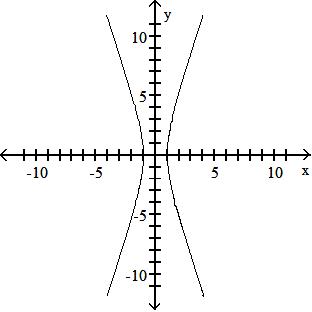
A) function domain: all real numbers range: {y|y ≤-1 or y ≥ 1} intercepts: (-1, 0), (1, 0) symmetry: y-axis
C) function domain: {x|x ≤-1 or x ≥ 1} range: all real numbers intercepts: (-1, 0), (1, 0) symmetry: x-axis, y-axis, origin
Objective: (1.2) Identify the Graph of a Function
B) function domain: {x|-1 ≤ x ≤ 1} range: all real numbers intercepts: (-1, 0), (1, 0) symmetry: x-axis, y-axis
D) not a function

A) function domain: {x|x > 0} range: all real numbers intercept: (0, 1)
symmetry: origin
C) function domain: {x|x > 0} range: all real numbers intercept: (1, 0)
symmetry: none
Objective: (1.2) Identify the Graph of a Function
67)

A) function
domain: all real numbers
range: {y|-1 ≤ y ≤ 1}
intercepts: π π (-π, 0), (- , 0), (0, 0), ( , 0), (π, 0) 2 2
symmetry: origin
C) function domain: {x|-π ≤ x ≤ π} range: {y|-1 ≤ y ≤ 1}
intercepts: π π (-π, 0), (- , 0), (0, 0), ( , 0), (π, 0) 2 2
symmetry: origin
Objective: (1.2) Identify the Graph of a Function
B) function domain: all real numbers range: {y|y > 0}
intercept: (1, 0)
symmetry: none
D) not a function
B) function domain: {x|-1 ≤ x ≤ 1}
range: {y|-π ≤ y ≤ π}
intercepts: π π (-π, 0), (- , 0), (0, 0), ( , 0), (π, 0) 2 2
symmetry: none
D) not a function

A) function domain: {x|x ≤ 9}
range: all real numbers intercepts: (-2, 0), (0, 8), (4, 0) symmetry: y-axis
C) function domain: all real numbers range: {y|y ≤ 9}
intercepts: (0, -2), (8, 0), (0, 4) symmetry: none
Objective: (1.2) Identify the Graph of a Function
69)
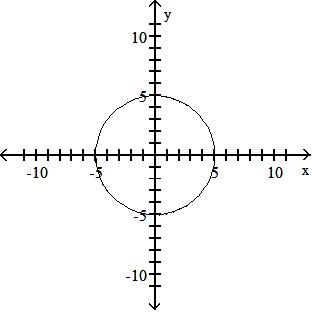
A) function
domain: {x|-5 ≤ x ≤ 5}
range: {y|-5 ≤ y ≤ 5}
intercepts: (-5, 0), (0, -5), (0, 0), (0, 5), (5, 0) symmetry: origin
C) function
domain: {x|-5 ≤ x ≤ 5}
range: {y|-5 ≤ y ≤ 5}
intercepts: (-5, 0), (0, -5), (0, 5), (5, 0) symmetry: x-axis, y-axis, origin
Objective: (1.2) Identify the Graph of a Function
B) function domain: all real numbers range: {y|y ≤ 9} intercepts: (-2, 0), (0, 8), (4, 0) symmetry: none
D) not a function
B) function
domain: {x|-5 ≤ x ≤ 5}
range: {y|-5 ≤ y ≤ 5}
intercepts: (-5, 0), (0, -5), (0, 5), (5, 0) symmetry: x-axis, y-axis
D) not a function

A) function domain: {x|x ≥ 0} range: {y|y ≥-2}
intercepts: (-2, 0), (0, 2), (2, 0)
symmetry: y-axis
C) function domain: {x|x ≥-2}
range: {y|y ≥ 0}
intercepts: (-2, 0), (0, 2), (2, 0)
symmetry: none
Objective: (1.2) Identify the Graph of a Function
71)
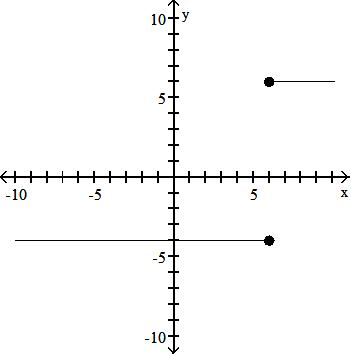
A) function domain: all real numbers range: all real numbers
intercept: (0, -4)
symmetry: none
C) function domain: {x|x = 6 or x =-4} range: all real numbers
intercept: (-4, 0)
symmetry: x-axis
Objective: (1.2) Identify the Graph of a Function
B) function domain: all real numbers range: all real numbers
intercepts: (-2, 0), (0, 2), (2, 0)
symmetry: none
D) not a function
B) function domain: all real numbers range: {y|y = 6 or y =-4}
intercept: (0, -4)
symmetry: none
D) not a function
The graph of a function f is given. Use the graph to answer the question.
72) Use the graph of f given below to find f(2).
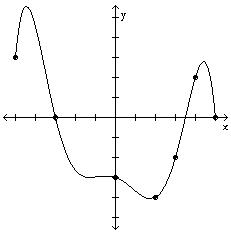
A) -4 B) 0
C) 2 D) 3
Objective: (1.2) Obtain Information from or about the Graph of a Function
73) Is f(-100) positive or negative?

A) positive
B) negative
Objective: (1.2) Obtain Information from or about the Graph of a Function
74) Is f(4) positive or negative?

A) positive B) negative
Objective: (1.2) Obtain Information from or about the Graph of a Function
75) For what numbers x is f(x) = 0?

1010 -10
A) -6, 7, 10 B) -6
(-10, -6), (7, 10)
Objective: (1.2) Obtain Information from or about the Graph of a Function
(-6, 7)

A) (-∞-3) B) (-3, ∞) C) (-3, 3.5) D) [-5, -3), (3.5, 5)
Objective: (1.2) Obtain Information from or about the Graph of a Function

A) (-15, ∞)
[-25, -15), (17.5, 25)
(-∞, -15)
Objective: (1.2) Obtain Information from or about the Graph of a Function
(-15, 17.5)
78) What is the domain of f?

A) {x|-8 ≤ x ≤ 11}
B) {x|-10 ≤ x ≤ 10}
C) all real numbers D) {x|x ≥ 0}
Objective: (1.2) Obtain Information from or about the Graph of a Function
79) What are the x-intercepts? 25 -2525 -25

A) -15, 17.5
B) -25, -15, 17.5, 25
C) -15, 17.5, 25
Objective: (1.2) Obtain Information from or about the Graph of a Function
D) -15
80) What is the y-intercept?

A) -16
B) 20
C) -12 D) 14
Objective: (1.2) Obtain Information from or about the Graph of a Function
81) How often does the line y =-100 intersect the graph?

A) once B) twice
C) three times D) does not intersect
Objective: (1.2) Obtain Information from or about the Graph of a Function
82) How often does the line y = 10 intersect the graph?

A) once B) twice C) three times D) does not intersect
Objective: (1.2) Obtain Information from or about the Graph of a Function
83) For which of the following values of x does f(x) = 4?
-10 10 -10

A) 4
B) 10
C) 14 D) 8
Objective: (1.2) Obtain Information from or about the Graph of a Function
Answer the question about the given function.
84) Given the function f(x) = 5x2 + 10x + 1, is the point (-1, -4) on the graph of f?
A) Yes
B) No
Objective: (1.2) Obtain Information from or about the Graph of a Function
85) Given the function f(x) =-7x2 - 14x + 4, is the point (-2, -10) on the graph of f?
A) Yes
B) No
Objective: (1.2) Obtain Information from or about the Graph of a Function
86) Given the function f(x) = 5x2 - 10x + 8, if x = 1, what is f(x)? What point is on the graph of f?
A) 3; (1, 3) B) 3; (3, 1)
C) 23; (23, 1)
Objective: (1.2) Obtain Information from or about the Graph of a Function
D) 23; (1, 23)
87) Given the function f(x) = 3x2 + 6x - 7, what is the domain of f?
A) all real numbers
B) {x|x ≥-1}
C) {x|x ≤-1}
Objective: (1.2) Obtain Information from or about the Graph of a Function
88) Given the function f(x) = x2 + 3x - 54, list the x-intercepts, if any, of the graph of f.
A) (9, 0), (6, 0)
B) (-9, 0), (1, 0)
C) (9, 0), (-6, 0)
Objective: (1.2) Obtain Information from or about the Graph of a Function
89) Given the function f(x) = 2x2 - 4x - 6, list the y-intercept, if there is one, of the graph of f.
A) -6 B) -2
C) -8
Objective: (1.2) Obtain Information from or about the Graph of a Function
90) Given the function x2 - 4 f(x) = x + 3 , is the point (-2, 0) on the graph of f?
A) Yes
B) No
Objective: (1.2) Obtain Information from or about the Graph of a Function
91) Given the function x2 - 9 f(x) = x - 3 , is the point 5 (-1, - ) 2 on the graph of f?
A) Yes B) No
Objective: (1.2) Obtain Information from or about the Graph of a Function
92) Given the function x2 - 5 f(x) = x - 1 , if x =-2, what is f(x)? What point is on the graph of f?
A) 1 1 ; (
Objective: (1.2) Obtain Information from or about the Graph of a Function
93) Given the function x2 + 3 f(x) = x - 9 , what is the domain of f?
A) {x|x ≠ 3}
{x|x ≠ 9}
1 {x|x ≠ } 3
Objective: (1.2) Obtain Information from or about the Graph of a Function
94) Given the function x2 + 6 f(x) = x - 7 , list the x-intercepts, if any, of the graph of f.
A) (- 6, 0)
B) (6, 0), (-6, 0)
C) (7, 0)
Objective: (1.2) Obtain Information from or about the Graph of a Function
95) Given the function x2 + 4 f(x) = x + 7 , list the y-intercept, if there is one, of the graph of f.
A) (0, -4)
B) (0, -7)
C) 4 (0, ) 7
Objective: (1.2) Obtain Information from or about the Graph of a Function
D) {x|x ≥ 1}
D) (-9, 0), (6, 0)
D) 0
{x|x ≠-9}
D) none
D) (4 , 0) 7
Solve the problem.
96) If an object weighs m pounds at sea level, then its weight W (in pounds) at a height of h miles above sea level is given approximately by 4000 2 W(h) = m 4000 + h . How much will a man who weighs 165 pounds at sea level weigh on the top of a mountain which is 14,494 feet above sea level? Round to the nearest hundredth of a pound, if necessary.
A) 165.23 pounds B) 165 pounds C) 7.72 pounds D) 164.77 pounds
Objective: (1.2) Obtain Information from or about the Graph of a Function
Match the function with the graph that best describes the situation.
97) The amount of rainfall as a function of time, if the rain fell more and more softly.



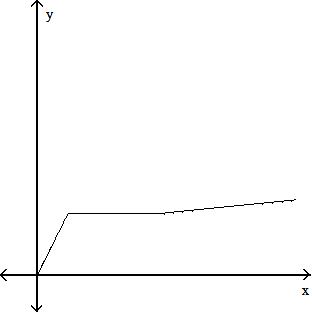
Objective: (1.2) Obtain Information from or about the Graph of a Function
98) The height of an animal as a function of time.
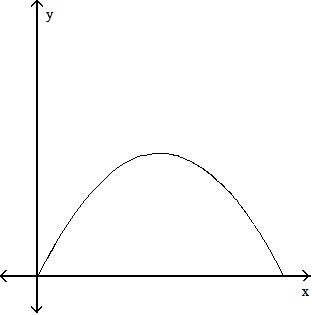



Objective: (1.2) Obtain Information from or about the Graph of a Function
SHORT ANSWER. Write the word or phrase that best completes each statement or answers the question.
Solve the problem.
99) Michael decides to walk to the mall to do some errands. He leaves home, walks 4 blocks in 14 minutes at a constant speed, and realizes that he forgot his wallet at home. So Michael runs back in 11 minutes. At home, it takes him 3 minutes to find his wallet and close the door. Michael walks 3 blocks in 12 minutes and then decides to jog to the mall. It takes him 9 minutes to get to the mall which is 3 blocks away. Draw a graph of Michael's distance from home (in blocks) as a function of time.
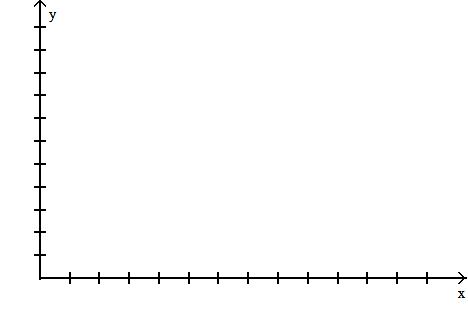
Objective: (1.2) Obtain Information from or about the Graph of a Function
MULTIPLE CHOICE. Choose the one alternative that best completes the statement or answers the question.
100) A steel can in the shape of a right circular cylinder must be designed to hold 700 cubic centimeters of juice (see figure). It can be shown that the total surface area of the can (including the ends) is given by 1400 S(r) = 2πr2 + r , where r is the radius of the can in centimeters. Using the TABLE feature of a graphing utility, find the radius that minimizes the surface area (and thus the cost) of the can. Round to the nearest tenth of a centimeter.

A) 0 cm
B) 4.8 cm
C) 4 cm
Objective: (1.2) Obtain Information from or about the Graph of a Function
D) 6 cm
101) The concentration C (arbitrary units) of a certain drug in a patient's bloodstream can be modeled using t C(t) = , 0.426t + 2.345 2 where t is the number of hours since a 500 milligram oral dose was administered. Using the TABLE feature of a graphing utility, find the time at which the concentration of the drug is greatest. Round to the nearest tenth of an hour.
A) 5.5 hours
B) 7.8 hours
C) 6.3 hours
Objective: (1.2) Obtain Information from or about the Graph of a Function
D) 7 hours
The graph of a function is given. Decide whether it is even, odd, or neither.

A) even
B) odd
Objective: (1.3) Determine Even and Odd Functions from a Graph
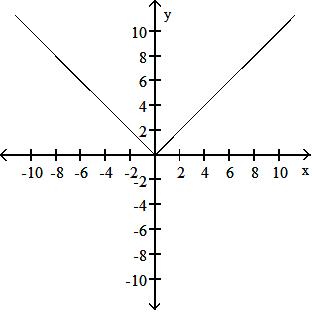
A) even B) odd
Objective: (1.3) Determine Even and Odd Functions from a Graph 104)
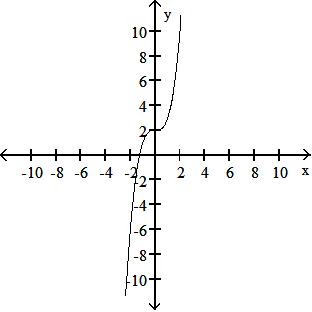
A) even
B) odd
Objective: (1.3) Determine Even and Odd Functions from a Graph
C) neither
C) neither
C) neither
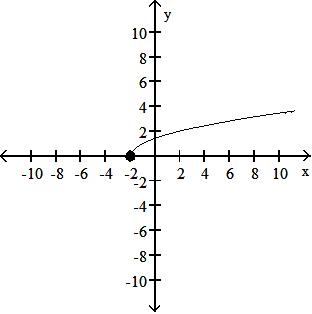
A) even
B) odd
Objective: (1.3) Determine Even and Odd Functions from a Graph

A) even B) odd
Objective: (1.3) Determine Even and Odd Functions from a Graph

A) even B) odd
Objective: (1.3) Determine Even and Odd Functions from a Graph
C) neither
C) neither
C) neither

A) even
B) odd
Objective: (1.3) Determine Even and Odd Functions from a Graph
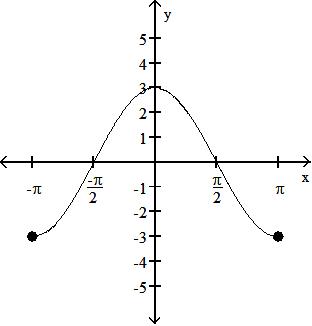
A) even
B) odd
Objective: (1.3) Determine Even and Odd Functions from a Graph
Determine algebraically whether the function is even, odd, or neither.
110) f(x) =-5x3
A) even
B) odd
Objective: (1.3) Identify Even and Odd Functions from the Equation
111) f(x) =-3x4 - x2
A) even
B) odd
Objective: (1.3) Identify Even and Odd Functions from the Equation
112) f(x) =-2x2 + 4
A) even
B) odd
Objective: (1.3) Identify Even and Odd Functions from the Equation
113) f(x) = 4x3 - 2
A) even
B) odd
Objective: (1.3) Identify Even and Odd Functions from the Equation
C) neither
C) neither
C) neither
C) neither
C) neither
C) neither
114) 3 f(x) = x
A) even
B) odd
Objective: (1.3) Identify Even and Odd Functions from the Equation
115) f(x) = x
A) even
B) odd
Objective: (1.3) Identify Even and Odd Functions from the Equation
116) 3 9x2 + 7
A) even
B) odd
Objective: (1.3) Identify Even and Odd Functions from the Equation
117) 1 f(x) = x2
A) even
B) odd
Objective: (1.3) Identify Even and Odd Functions from the Equation
118) x f(x) = x2 + 3
A) even
B) odd
Objective: (1.3) Identify Even and Odd Functions from the Equation
119) -x3 f(x) = 4x2 - 5
A) even
B) odd
Objective: (1.3) Identify Even and Odd Functions from the Equation
120) -2x f(x) = |x|
A) even
B) odd
Objective: (1.3) Identify Even and Odd Functions from the Equation
C) neither
C) neither
C) neither
C) neither
C) neither
C) neither
C) neither
The graph of a function is given. Determine whether the function is increasing, decreasing, or constant on the given interval.
121) 5 (- 5, - ) 2

A) increasing
B) decreasing C) constant
Objective: (1.3) Use a Graph to Determine Where a Function Is Increasing, Decreasing, or Constant
122) (- 2, 0)

A) constant
B) increasing C) decreasing Objective: (1.3) Use a Graph to Determine Where a Function Is Increasing, Decreasing, or Constant
123) (0, 1)
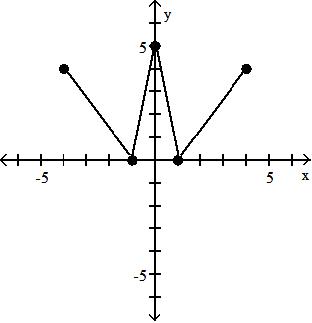
A) constant
B) increasing C) decreasing
Objective: (1.3) Use a Graph to Determine Where a Function Is Increasing, Decreasing, or Constant
124) (1, 2)

A) constant
B) increasing
C) decreasing
Objective: (1.3) Use a Graph to Determine Where a Function Is Increasing, Decreasing, or Constant
125) (0, 3)

A) constant
B) decreasing
C) increasing
Objective: (1.3) Use a Graph to Determine Where a Function Is Increasing, Decreasing, or Constant
126) (-3, 0)

A) increasing
B) constant C) decreasing
Objective: (1.3) Use a Graph to Determine Where a Function Is Increasing, Decreasing, or Constant
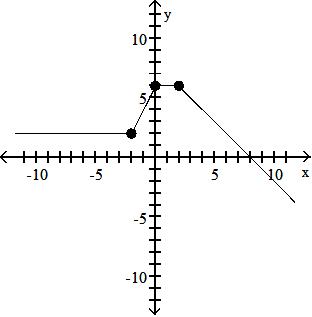
A) increasing
B) constant
C) decreasing
Objective: (1.3) Use a Graph to Determine Where a Function Is Increasing, Decreasing, or Constant
128) (-3, ∞)
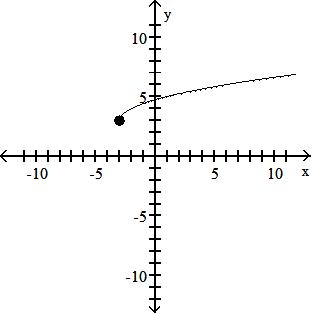
A) decreasing
B) increasing
C) constant
Objective: (1.3) Use a Graph to Determine Where a Function Is Increasing, Decreasing, or Constant
129) (0, 1)

A) constant B) decreasing
C) increasing
Objective: (1.3) Use a Graph to Determine Where a Function Is Increasing, Decreasing, or Constant

A) increasing B) constant C) decreasing
Objective: (1.3) Use a Graph to Determine Where a Function Is Increasing, Decreasing, or Constant
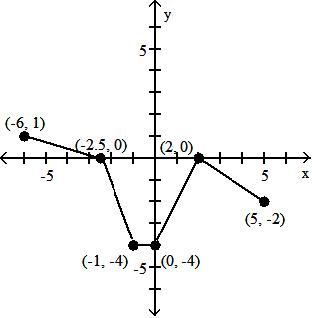
A) constant
B) increasing
C) decreasing
Objective: (1.3) Use a Graph to Determine Where a Function Is Increasing, Decreasing, or Constant

A) increasing
B) constant C) decreasing
Objective: (1.3) Use a Graph to Determine Where a Function Is Increasing, Decreasing, or Constant
Use the graph to find the intervals on which it is increasing, decreasing, or constant.
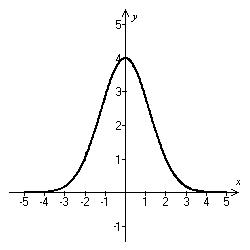
A) Increasing on (-∞, ∞)
C) Decreasing on (-∞, 0); increasing on (0, ∞)
B) Decreasing on (-∞, ∞)
D) Increasing on (-∞, 0); decreasing on (0, ∞)
Objective: (1.3) Use a Graph to Determine Where a Function Is Increasing, Decreasing, or Constant
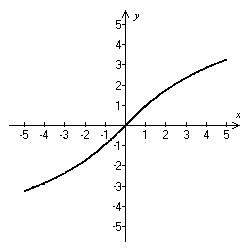
A) Increasing on (-∞, 0); decreasing on (0, ∞)
C) Decreasing on (-∞, ∞)
B) Increasing on (-∞, ∞)
D) Decreasing on (-∞, 0); increasing on (0, ∞)
Objective: (1.3) Use a Graph to Determine Where a Function Is Increasing, Decreasing, or Constant
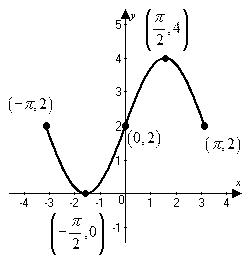
A) Decreasing on π - π,2 and π , π 2 ; increasing on π π, 2 2
B) Increasing on (-∞, ∞)
C) Decreasing on - π, 0 ; increasing on 0, π
D) Increasing on π - π,2 and π , π 2 ; decreasing on π π, 2 2
Objective: (1.3) Use a Graph to Determine Where a Function Is Increasing, Decreasing, or Constant

A) Decreasing on (-3, -1) and (1, 4); increasing on (-2, 1)
B) Decreasing on (-3, -2) and (2, 4); increasing on (-1, 1)
C) Increasing on (-3, -2) and (2, 4); decreasing on (-1, 1); constant on (-2, -1) and (1, 2)
D) Decreasing on (-3, -2) and (2, 4); increasing on (-1, 1); constant on (-2, -1) and (1, 2)
Objective: (1.3) Use a Graph to Determine Where a Function Is Increasing, Decreasing, or Constant
The graph of a function f is given. Use the graph to answer the question.
137) Find the numbers, if any, at which f has a local maximum. What are the local maxima?

A) f has a local maximum at x = 1; the local maximum is 3
B) f has a local maximum at x = 0; the local maximum is 3
C) f has a local maximum at x =-1 and 1; the local maximum is 0
D) f has no local maximum
Objective: (1.3) Use a Graph to Locate Local Maxima and Local Minima
138) Find the numbers, if any, at which f has a local minimum. What are the local minima?
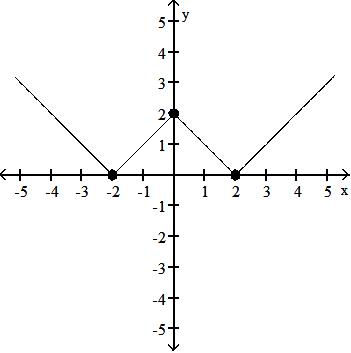
A) f has a local minimum at x =-2; the local minimum is 0
B) f has a local minimum at x =-2 and 2; the local minimum is 0
C) f has a local minimum at x = 0; the local minimum is 2
D) f has no local minimum
Objective: (1.3) Use a Graph to Locate Local Maxima and Local Minima
139) Find the numbers, if any, at which f has a local maximum. What are the local maxima?

A) f has a local maximum at x =-π and π; the local maximum is -1
B) f has a local maximum at -π; the local maximum is 1
C) f has a local maximum at x = 0; the local maximum is 1
D) f has no local maximum
Objective: (1.3) Use a Graph to Locate Local Maxima and Local Minima
140) Find the numbers, if any, at which f has a local minimum. What are the local minima?

A) f has a local minimum at x =-π and π; the local minimum is 2
B) f has no local minimum
C) f has a local minimum at x =-π; the local minimum is -2
D) f has a local minimum at x = 0; the local minimum is -2
Objective: (1.3) Use a Graph to Locate Local Maxima and Local Minima

Find the numbers, if any, at which f has a local maximum. What are the local maxima?
A) f has a local minimum at x = 5 and 3.9; the local minimum at 5 is -8; the local minimum at 3.9 is 2.2
B) f has a local maximum at x = 5 and 3.9; the local maximum at 5 is -8; the local maximum at 3.9 is 2.2
C) f has a local minimum at x =-8 and 2.2; the local minimum at -8 is 5; the local minimum at 2.2 is 3.9
D) f has a local maximum at x =-8 and 2.2; the local maximum at -8 is 5; the local maximum at 2.2 is 3.9
Objective: (1.3) Use a Graph to Locate Local Maxima and Local Minima
Solve the problem.
142) The height s of a ball (in feet) thrown with an initial velocity of 70 feet per second from an initial height of 5 feet is given as a function of time t (in seconds) by s(t) = -16t2 + 70t + 5 What is the maximum height? Round to the nearest hundredth, if necessary.

Objective: (1.3) Use a Graph to Locate Local Maxima and Local Minima
For the graph of the function y = f(x), find the absolute maximum and the absolute minimum, if it exists.
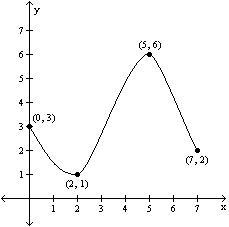
A) Absolute maximum: f(5) = 6; Absolute minimum: f(2) = 1
B) Absolute maximum: f(7) = 2; Absolute minimum: f(0) = 3
C) Absolute maximum: f(2) = 7; Absolute minimum: f(3) = 0
D) Absolute maximum: f(6) = 5; Absolute minimum: f(1) = 2
Objective: (1.3) Use a Graph to Locate the Absolute Maximum and the Absolute Minimum

A) Absolute maximum: f(3) = 6; Absolute minimum: f(5) = 1
B) Absolute maximum: f(3) = 6; Absolute minimum: none
C) Absolute maximum: f(3) = 6; Absolute minimum: f(0) = 2
D) Absolute maximum: f(7) = 4; Absolute minimum: f(0) = 2
Objective: (1.3) Use a Graph to Locate the Absolute Maximum and the Absolute Minimum
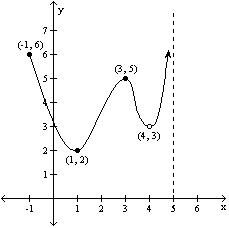
A) Absolute maximum: f(-1) = 6; Absolute minimum: f(1) = 2
B) Absolute maximum: f(3) = 5; Absolute minimum: f(1) = 2
C) Absolute maximum: none; Absolute minimum: none
D) Absolute maximum: none; Absolute minimum: f(1) = 2
Objective: (1.3) Use a Graph to Locate the Absolute Maximum and the Absolute Minimum

A) Absolute maximum: f(4) = 7; Absolute minimum: f(1) = 2
B) Absolute maximum: none; Absolute minimum: f(1) = 2
C) Absolute maximum: none; Absolute minimum: none
D) Absolute maximum: f(4) = 7; Absolute minimum: none
Objective: (1.3) Use a Graph to Locate the Absolute Maximum and the Absolute Minimum
Use a graphing utility to graph the function over the indicated interval and approximate any local maxima and local minima. Determine where the function is increasing and where it is decreasing. If necessary, round answers to two decimal places.
147) f(x) = x3 - 3x2 + 3, (-1, 3)
A) local maximum at (0, 3)
local minimum at (2, -1) increasing on (-1, 0) and (2, 3) decreasing on (0, 2)
C) local maximum at (2, -1)
local minimum at (0, 3) increasing on (-1, 0) and (2, 3) decreasing on (0, 2)
B) local maximum at (2, -1) local minimum at (0, 3) increasing on (-1, 0) decreasing on (0, 2)
D) local maximum at (0, 3) local minimum at (2, -1) increasing on (0, 2) decreasing on (-1, 0) and (2, 3)
Objective: (1.3) Use Graphing Utility to Approximate Local Maxima/Minima and to Determine Where Function Is Incrs/Decrs
SHORT ANSWER. Write the word or phrase that best completes each statement or answers the question.
148) f(x) = x3 - 4x2 + 6; (-1, 4)
Objective: (1.3) Use Graphing Utility to Approximate Local Maxima/Minima and to Determine Where Function Is Incrs/Decrs
149) f(x) = x5 - x2; (-2, 2)
Objective: (1.3) Use Graphing Utility to Approximate Local Maxima/Minima and to Determine Where Function Is Incrs/Decrs
150) f(x) =-0.3x3 + 0.2x2 + 4x - 5; (-4, 5)
Objective: (1.3) Use Graphing Utility to Approximate Local Maxima/Minima and to Determine Where Function Is Incrs/Decrs
151) f(x) = 0.15x4 + 0.3x3 - 0.8x2 + 5; (-4, 2)
Objective: (1.3) Use Graphing Utility to Approximate Local Maxima/Minima and to Determine Where Function Is Incrs/Decrs
MULTIPLE CHOICE. Choose the one alternative that best completes the statement or answers the question.
Use a graphing utility to graph the function over the indicated interval and approximate any local maxima and local minima. If necessary, round answers to two decimal places.
152) f(x) = x2 + 2x - 3; (-5, 5)
A) local minimum at (1, 4)
C) local maximum at (1, -4)
B) local minimum at (-1, -4)
D) local maximum at (-1, 4)
Objective: (1.3) Use Graphing Utility to Approximate Local Maxima/Minima and to Determine Where Function Is Incrs/Decrs
153) f(x) = 2 + 8x - x2; (-5, 5)
A) local maximum at (-4, 50)
C) local minimum at (-4, 18)
B) local maximum at (4, 18)
D) local minimum at (4, 50)
Objective: (1.3) Use Graphing Utility to Approximate Local Maxima/Minima and to Determine Where Function Is Incrs/Decrs
154) f(x) = x3 - 3x2 + 1; (-5, 5)
A) local minimum at (2, -3)
C) local minimum at (0, 1) local maximum at (2, -3)
B) local maximum at (0, 1) local minimum at (2, -3)
D) none
Objective: (1.3) Use Graphing Utility to Approximate Local Maxima/Minima and to Determine Where Function Is Incrs/Decrs
155) f(x) = x3 - 12x + 2; (-5, 5)
A) local maximum at (-2, 18) local minimum at (2, -14)
C) local maximum at (-2, 18) local minimum at (0, 0) local minimum at (2, -14)
B) local minimum at (0, 0)
D) none
Objective: (1.3) Use Graphing Utility to Approximate Local Maxima/Minima and to Determine Where Function Is Incrs/Decrs
156) f(x) = x4 - 5x3 + 3x2 + 9x - 3; (-5, 5)
A) local minimum at (-0.57, -6.12) local maximum at (1.32, 5.64) local minimum at (3, -3)
C) local minimum at (-1, -6) local maximum at (1, 6) local minimum at (3, -3)
B) local minimum at (-3, -3) local maximum at (-1.32, 5.64) local minimum at (0.57, -6.12)
D) local minimum at (-0.61, -5.64) local maximum at (1.41, 6.12) local minimum at (3, -3)
Objective: (1.3) Use Graphing Utility to Approximate Local Maxima/Minima and to Determine Where Function Is Incrs/Decrs
For the function, find the average rate of change of f from 1 to x: f(x) - f(1) , x ≠ 1 x - 1 157) f(x) =-9x A) -10
-9
Objective: (1.3) Find the Average Rate of Change of a Function
158) f(x) = x3 + x
x3 + x + 2 x - 1
x2+ x + 2
Objective: (1.3) Find the Average Rate of Change of a Function
159) 8 f(x) = x + 7
8 x(x + 7)
8 (x - 1)(x + 7)
Objective: (1.3) Find the Average Rate of Change of a Function
1
x2+ 2
160) f(x) = x + 63 A) x + 63 - 8 x + 1
x + 63 - 8 x - 1
Objective: (1.3) Find the Average Rate of Change of a Function
Find the average rate of change for the function between the given values.
161) f(x) =-3x + 6; from 1 to 2
A) 6 B) 3
Objective: (1.3) Find the Average Rate of Change of a Function
162) f(x) = x2 + 2x; from 1 to 3 A) 4
5
Objective: (1.3) Find the Average Rate of Change of a Function
163) f(x) = 9x3 + 7x2 - 3; from -7 to 4
A) 685 11 B) 858
Objective: (1.3) Find the Average Rate of Change of a Function
164) f(x) = 2x; from 2 to 8
310
1 3
Objective: (1.3) Find the Average Rate of Change of a Function
-3
x + 63 + 8 x + 1
6
-6
x + 63 + 8 x - 1
2
685 4
15 2
165) 3 f(x) = x - 2 ; from 4 to 7 A) 2 B) 7 C) 1 3
Objective: (1.3) Find the Average Rate of Change of a Function
166) f(x) = 4x2; from 0 to 7 4 A) 7
2
Objective: (1.3) Find the Average Rate of Change of a Function
167) f(x) =-3x2 - x; from 5 to 6 A) 1 2
16
Objective: (1.3) Find the Average Rate of Change of a Function
168) f(x) = x3 + x2 - 8x - 7; from 0 to 2
310
312
7
310
1 3
-2
-34
A) 1 2 B) -2 C) 16 D) -28
Objective: (1.3) Find the Average Rate of Change of a Function
169) f(x) = 2x - 1; from 1 to 5
-28
16
Objective: (1.3) Find the Average Rate of Change of a Function
170) 3 f(x) = ; x + 2 from 1 to 4 A) -28 B) -2
Objective: (1.3) Find the Average Rate of Change of a Function
Find an equation of the secant line containing (1, f(1)) and (2, f(2)).
171) f(x) = x2 - 2x
A) y = x - 2
y = x + 2
Objective: (1.3) Find the Average Rate of Change of a Function
1 2
1 2
y =-x + 2
172) 5 f(x) = x + 4 A) 17 y = x + 65 B) 15 y = x + 66 C) 51 y = x + 66
Objective: (1.3) Find the Average Rate of Change of a Function
173) f(x) = x + 8
A) y = (- 10 + 3)x + 10 - 6 B) y = ( 10 - 3)x - 10 + 6 C) y = (- 10 - 3)x - 10 + 6 D) y = ( 10 - 3)x + 10 - 6
Objective: (1.3) Find the Average Rate of Change of a Function
Match the graph to the function listed whose graph most resembles the one given. 174)
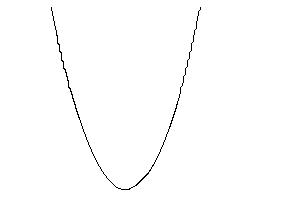
A) cube function
B) reciprocal function C) absolute value function D) square function
Objective: (1.4) Graph the Functions Listed in the Library of Functions
175)

A) linear function C) absolute value function
B) reciprocal function D) constant function
Objective: (1.4) Graph the Functions Listed in the Library of Functions
-2
16
y =-x - 2
177)
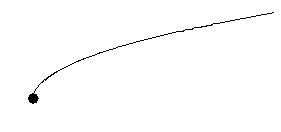
A) square root function C) square function
B) cube root function D) cube function
Objective: (1.4) Graph the Functions Listed in the Library of Functions

A) absolute value function
B) reciprocal function C) square function D) linear function
Objective: (1.4) Graph the Functions Listed in the Library of Functions
178)

A) linear function
B) absolute value function C) constant function D) reciprocal function
Objective: (1.4) Graph the Functions Listed in the Library of Functions
179)
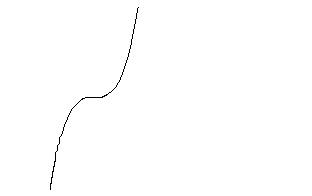
A) square function
B) cube root function C) cube function D) square root function
Objective: (1.4) Graph the Functions Listed in the Library of Functions
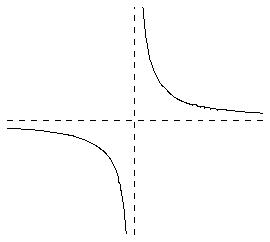
A) square function
C) reciprocal function
B) square root function
D) absolute value function
Objective: (1.4) Graph the Functions Listed in the Library of Functions 181)

A) cube root function
C) square root function
B) square function
D) cube function
Objective: (1.4) Graph the Functions Listed in the Library of Functions
Graph the function.
182) f(x) = x



Objective: (1.4) Graph the Functions Listed in the Library of Functions
183) f(x) = x2





Objective: (1.4) Graph the Functions Listed in the Library of Functions
184) f(x) = x3

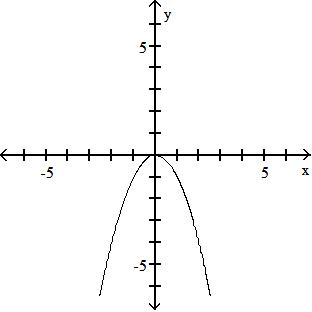
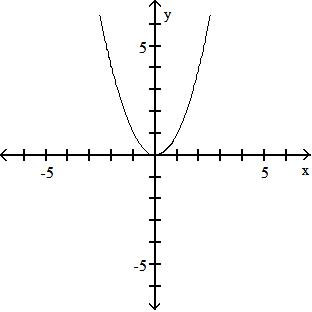


Objective: (1.4) Graph the Functions Listed in the Library of Functions
185) f(x) = x
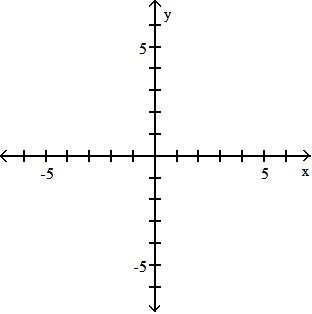




Objective: (1.4) Graph the Functions Listed in the Library of Functions
186) f(x) = 1 x




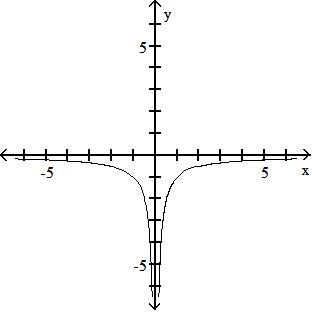
Objective: (1.4) Graph the Functions Listed in the Library of Functions
187) f(x) = x




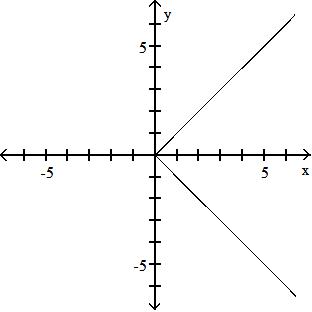
Objective: (1.4) Graph the Functions Listed in the Library of Functions
188) f(x) = 3 x


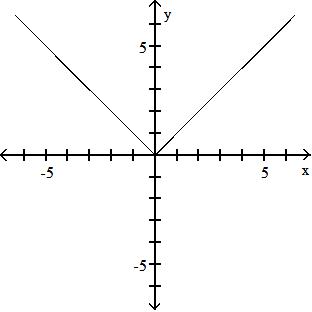


Objective: (1.4) Graph the Functions Listed in the Library of Functions
189) f(x) =-3




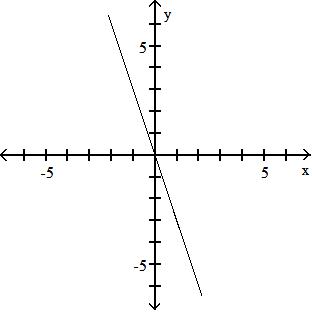
Objective: (1.4) Graph the Functions Listed in the Library of Functions 190)
f(x) = x - 5 if x < 1 -2 if x ≥ 1




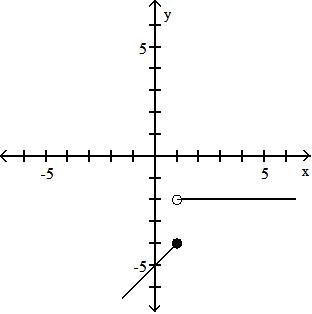
Objective: (1.4) Graph Piecewise-defined Functions
191)
f(x) = -x + 3 if x < 2 2x - 3 if x ≥ 2


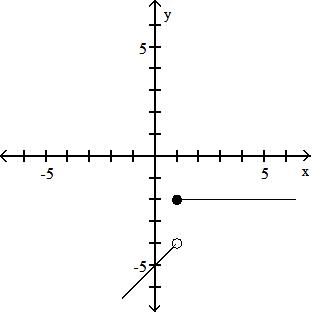
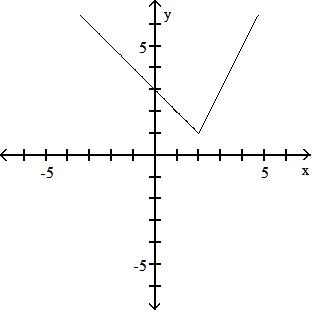

Objective: (1.4) Graph Piecewise-defined Functions
192)
f(x) = -x + 2 x < 0 x + 3 x ≥ 0

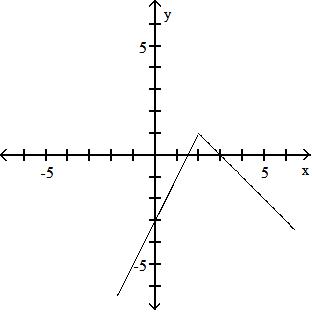
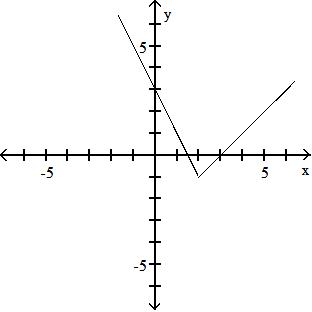
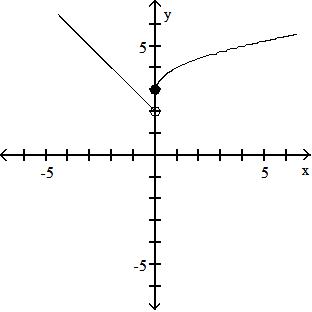
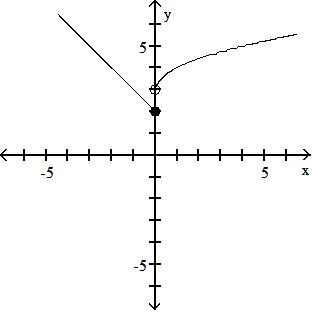
Objective: (1.4) Graph Piecewise-defined Functions
193)
f(x) = x + 1 if -8 ≤ x <-4 -9 if x =-4 -x - 3 if x >-4


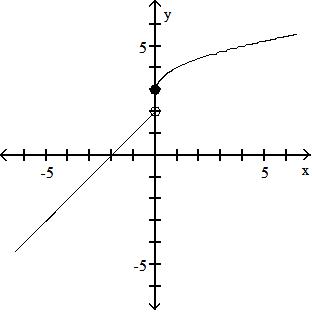
194)


Objective: (1.4) Graph Piecewise-defined Functions
1 if -2 ≤ x < 6
f(x) = |x| if 6 ≤ x < 8
x if 8 ≤ x ≤ 13


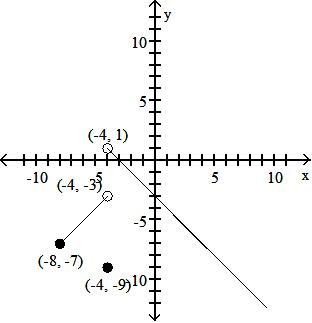
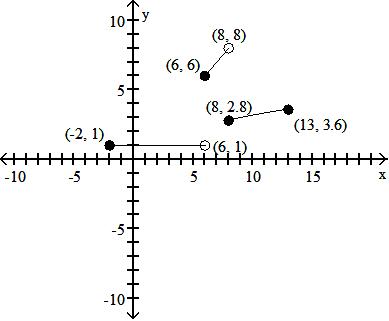

Objective: (1.4) Graph Piecewise-defined Functions
Find the domain of the function.
195)
f(x) = -4x if x ≠ 0 -3 if x = 0


A) {x|x ≠ 0} B) all real numbers C) {x|x ≤ 0} D) {0}
Objective: (1.4) Graph Piecewise-defined Functions
196)
f(x) = 1 if -4 ≤ x <-3 |x| if -3 ≤ x < 4 3 x if 4 ≤ x ≤ 26
A) {x|-4 ≤ x < 4 or 4 < x ≤ 26} B) {x|-4 ≤ x ≤ 26} C) {x|x ≥-4} D) {x|4 ≤ x ≤ 26}
Objective: (1.4) Graph Piecewise-defined Functions
Locate any intercepts of the function.
197)
f(x) = -5x + 9 if x < 1 9x - 5 if x ≥ 1
A) (0, -5), ( 9 5 , 0), ( 5 9 , 0) B) (0, 9)
Objective: (1.4) Graph Piecewise-defined Functions
198)
f(x) = 1 if -7 ≤ x <-4 |x| if -4 ≤ x < 7
x if 7 ≤ x ≤ 24
A) (0, 0), (1, 0) B) (0, 0)
Objective: (1.4) Graph Piecewise-defined Functions
Based on the graph, find the range of y = f(x).
199)
f(x) = 1 2 x if x ≠ 0 8 if x = 0

A) (-∞, 0) or {0} or (0, ∞)
C) (0, 9), ( 9 5 , 0), ( 5 9 , 0) D) (0, -5)
C) (0, 0), (0, 1) D) none
B) (-10, 10) C) (-∞, ∞) D) (-∞, 0) or (0, ∞)
Objective: (1.4) Graph Piecewise-defined Functions
f(x) = 4 if -5 ≤ x <-2 |x| if -2 ≤ x < 7
x if 7 ≤ x ≤ 13

A) [0, 13]
B) [0, 7)
Objective: (1.4) Graph Piecewise-defined Functions
C) [0, ∞)
The graph of a piecewise-defined function is given. Write a definition for the function. 201)

A)
B)
1 - x if -4 < x < 0
f(x) = 2
x if 0 < x < 3
C)
f(x) -2x if -4 ≤ x ≤ 0 = x if 0 < x ≤ 3
Objective: (1.4) Graph Piecewise-defined Functions
D)
1 x if -4 < x < 0
f(x) = 2
x if 0 < x < 3
1 - x if -4 ≤ x ≤ 0
f(x) = 2
x if 0 < x ≤ 3
D) [0, 7]
C)

f(x) = x + 1 if 0 ≤ x ≤ 3 1 2 x + 1 2 if 3 < x ≤ 5
f(x) = x + 1 if 0 ≤ x ≤ 3 1 2 x if 3 < x ≤ 5
Objective: (1.4) Graph Piecewise-defined Functions
203) A)
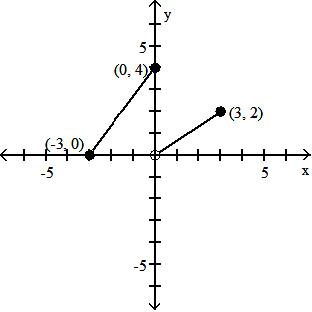
f(x) = 4 3 x + 4 if -3 ≤ x ≤ 0 2 3 x if 0 < x ≤ 3
f(x) = x + 1 if 0 ≤ x ≤ 3 1 2 x + 2 if 3 < x ≤ 5
f(x) = x + 1 if 0 ≤ x ≤ 3 1 2 x1 2 if 3 < x ≤ 5
f(x) = 4 3 x + 4 if -3 ≤ x ≤ 0 2 3 x + 2 if 0 < x ≤ 3 C)
f(x) = 4 3 x - 4 if -3 ≤ x ≤ 0 2 3 x if 0 ≤ x ≤ 3
Objective: (1.4) Graph Piecewise-defined Functions
= 3 4 x + 4 if -3 ≤ x ≤ 0 3 2 x if 0 < x ≤ 3

=
Objective: (1.4) Graph Piecewise-defined Functions
Solve the problem.
205) If f(x) = int(2x), find f(1.8).
3
2
Objective: (1.4) Graph Piecewise-defined Functions
4
1
SHORT ANSWER. Write the word or phrase that best completes each statement or answers the question.
206) A gas company has the following rate schedule for natural gas usage in single-family residences:
What is the charge for using 25 therms in one month?
What is the charge for using 45 therms in one month?
Construct a function that gives the monthly charge C for x therms of gas.
Objective: (1.4) Graph Piecewise-defined Functions
207) An electric company has the following rate schedule for electricity usage in single-family residences:
Monthly service charge
Per kilowatt service charge
1st 300 kilowatts
Over 300 kilowatts
$4.93
$0.11589/kW
$0.13321/kW
What is the charge for using 300 kilowatts in one month?
What is the charge for using 375 kilowatts in one month?
Construct a function that gives the monthly charge C for x kilowatts of electricity.
Objective: (1.4) Graph Piecewise-defined Functions
208) One Internet service provider has the following rate schedule for high-speed Internet service:
Monthly service charge
$18.00
1st 50 hours of use free
Next 50 hours of use
Over 100 hours of use
$0.25/hour
$1.00/hour
What is the charge for 50 hours of high-speed Internet use in one month?
What is the charge for 75 hours of high-speed Internet use in one month?
What is the charge for 135 hours of high-speed Internet use in one month?
Objective: (1.4) Graph Piecewise-defined Functions
209) The wind chill factor represents the equivalent air temperature at a standard wind speed that would produce the same heat loss as the given temperature and wind speed. One formula for computing the equivalent temperature is
W(t) = t 33(10.45 +
where v represents the wind speed (in meters per second) and t represents the air temperature (°C). Compute the wind chill for an air temperature of 15°C and a wind speed of 12 meters per second. (Round the answer to one decimal place.)
Objective: (1.4) Graph Piecewise-defined Functions
210) A cellular phone plan had the following schedule of charges:
Basic service, including 100 minutes of calls
2nd 100 minutes of calls
Additional minutes of calls
What is the charge for 200 minutes of calls in one month?
What is the charge for 250 minutes of calls in one month?
$20.00 per month
$0.075 per minute
$0.10 per minute
Construct a function that relates the monthly charge C for x minutes of calls.
Objective: (1.4) Graph Piecewise-defined Functions
MULTIPLE CHOICE. Choose the one alternative that best completes the statement or answers the question.
Graph the function by starting with the graph of the basic function and then using the techniques of shifting, compressing, stretching, and/or reflecting.
211) f(x) = x2 + 1
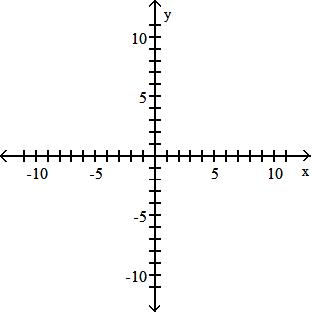


(1.5) Graph Functions Using Vertical and Horizontal Shifts



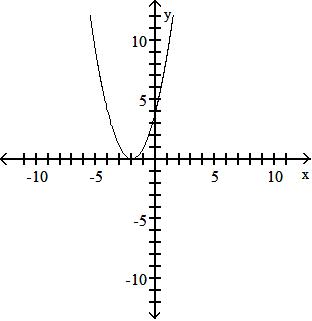

Objective: (1.5) Graph Functions Using Vertical and Horizontal Shifts

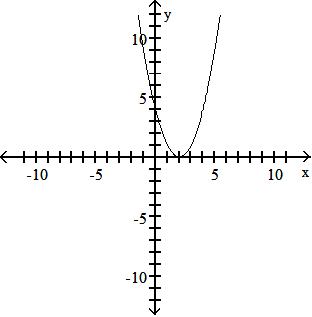



Objective: (1.5) Graph Functions Using Vertical and Horizontal Shifts




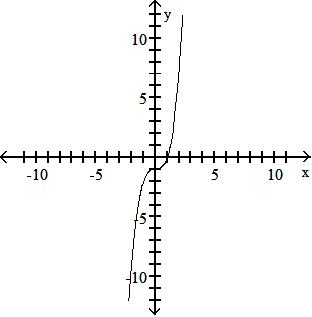
Objective: (1.5) Graph Functions Using Vertical and Horizontal Shifts

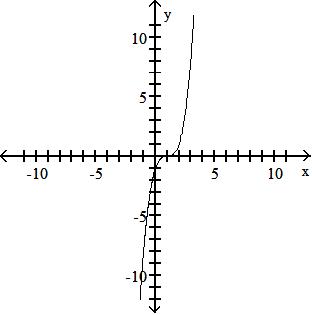



Objective: (1.5) Graph Functions Using Vertical and Horizontal Shifts





Objective: (1.5) Graph Functions Using Vertical and Horizontal Shifts




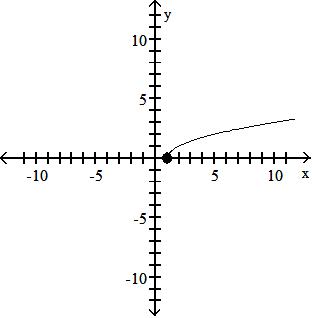
Objective: (1.5) Graph Functions Using Vertical and Horizontal Shifts



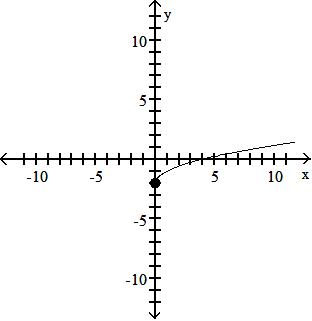
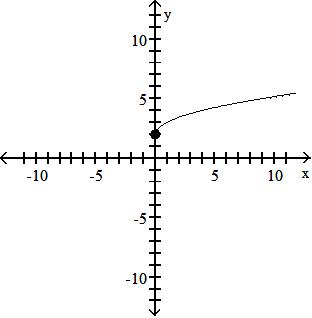
Objective: (1.5) Graph Functions Using Vertical and Horizontal Shifts

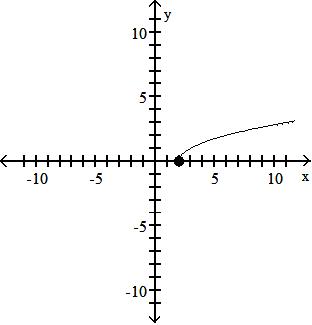

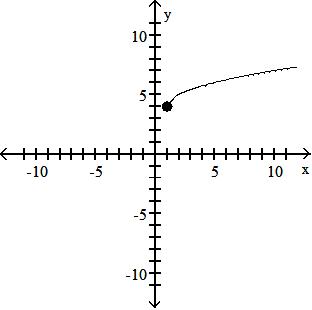
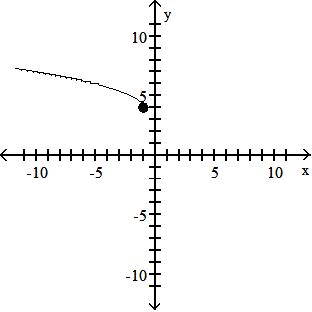
Objective: (1.5) Graph Functions Using Vertical and Horizontal Shifts



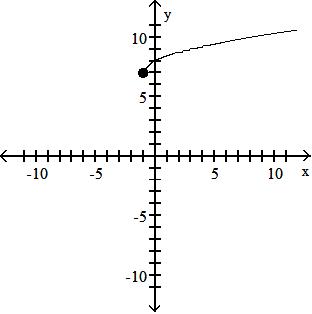

Objective: (1.5) Graph Functions Using Vertical and Horizontal Shifts

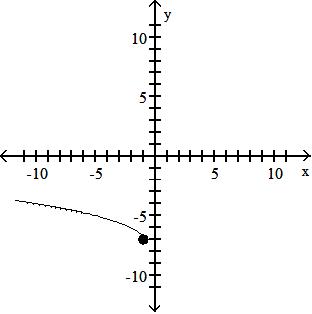



Objective: (1.5) Graph Functions Using Vertical and Horizontal Shifts





Objective: (1.5) Graph Functions Using Vertical and Horizontal Shifts

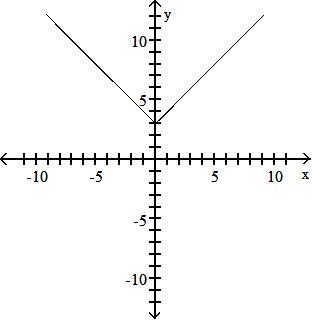

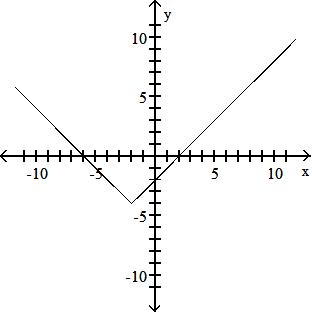

Objective: (1.5) Graph Functions Using Vertical and Horizontal Shifts



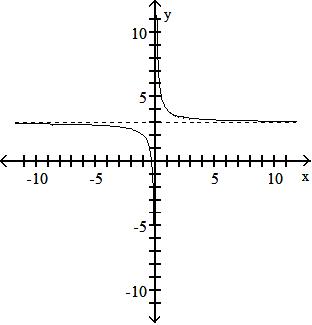

Objective: (1.5) Graph Functions Using Vertical and Horizontal Shifts
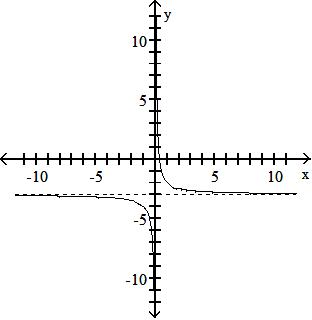




Objective: (1.5) Graph Functions Using Vertical and Horizontal Shifts
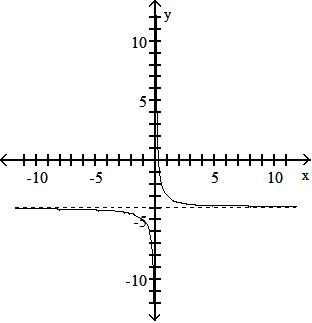
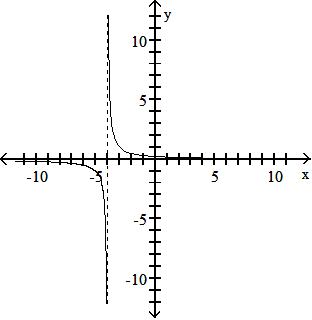



Objective: (1.5) Graph Functions Using Vertical and Horizontal Shifts


Match the correct function to the graph. 227)

A) y = x + 1
B) y = x - 1
C) y = x - 1 D) y = x
Objective: (1.5) Graph Functions Using Vertical and Horizontal Shifts 228)
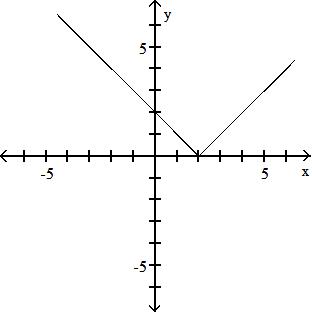
A) y = |x + 2|
y = |1 - x| C) y = x - 2
Objective: (1.5) Graph Functions Using Vertical and Horizontal Shifts
Using transformations, sketch the graph of the requested function.
y = |2 - x|
229) The graph of a function f is illustrated. Use the graph of f as the first step toward graphing the function F(x), where F(x) = f(x + 2) - 1.



Objective: (1.5) Graph Functions Using Vertical and Horizontal Shifts

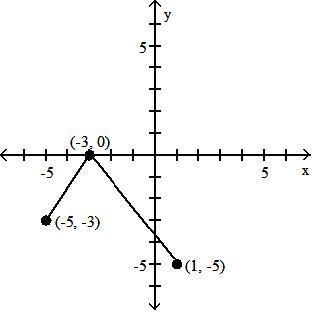
Suppose the point (2, 4) is on the graph of y = f(x). Find a point on the graph of the given function.
230) y = f(x + 2)
(4, 4)
(2, 6)
Objective: (1.5) Graph Functions Using Vertical and Horizontal Shifts
(2, 2)
(0, 4)
231) f(x) + 2
(4, 4)
(0, 4)
Objective: (1.5) Graph Functions Using Vertical and Horizontal Shifts
(2, -2)
(2, 6)
Graph the function by starting with the graph of the basic function and then using the techniques of shifting, compressing, stretching, and/or reflecting.
232) f(x) = 2x2


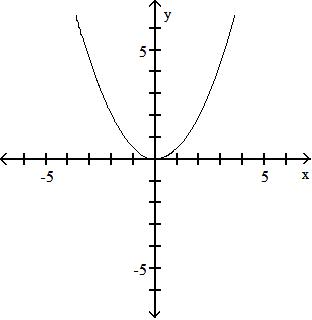
Objective: (1.5) Graph Functions Using Compressions and Stretches
233) f(x) = 1 2 x2


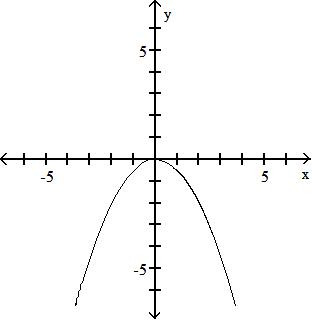


Objective: (1.5) Graph Functions Using Compressions and Stretches
234) f(x) = 2x3


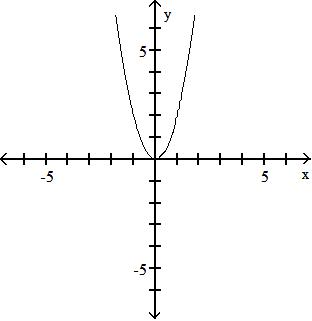
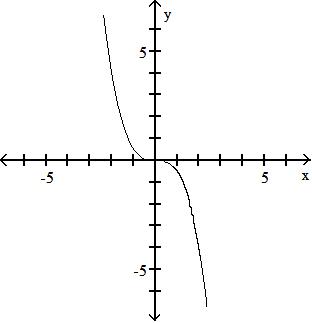

Objective: (1.5) Graph Functions Using Compressions and Stretches
235) f(x) = 1 3 x3



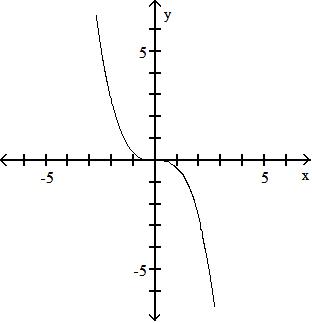
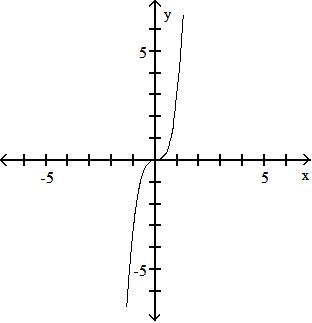
Objective: (1.5) Graph Functions Using Compressions and Stretches
236) f(x) = 4 x


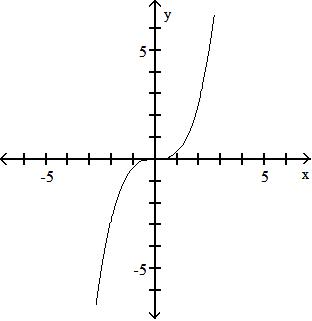

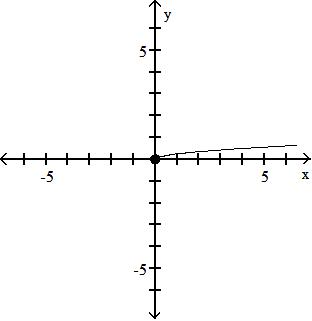
Objective: (1.5) Graph Functions Using Compressions and Stretches
237) f(x) = 1 7 x




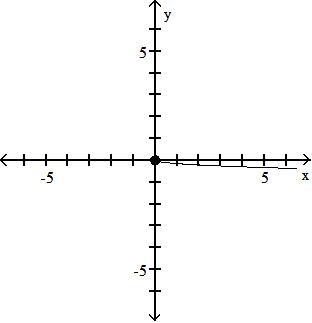
Objective: (1.5) Graph Functions Using Compressions and Stretches
238) f(x) = 2|x|


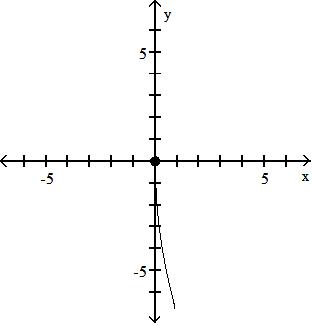


Objective: (1.5) Graph Functions Using Compressions and Stretches
239) f(x) = 1 6 |x|

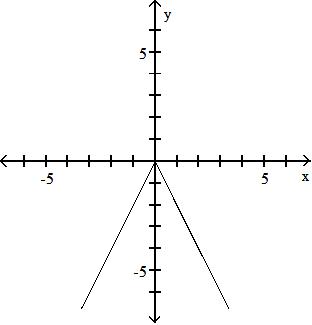

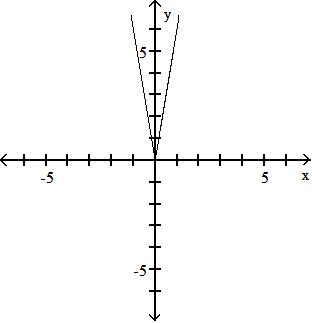

Objective: (1.5) Graph Functions Using Compressions and Stretches
240) f(x) = 6 x


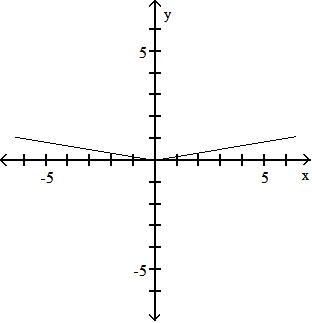
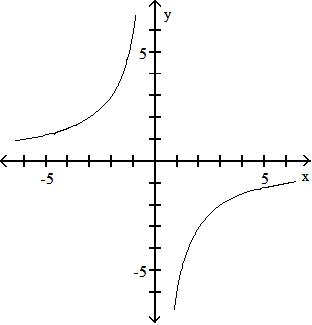
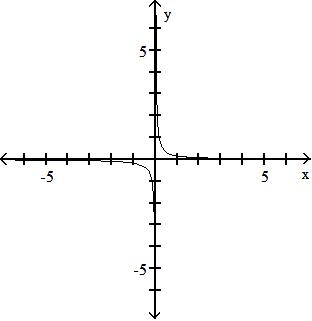
Objective: (1.5) Graph Functions Using Compressions and Stretches
241) f(x) = 1 2x


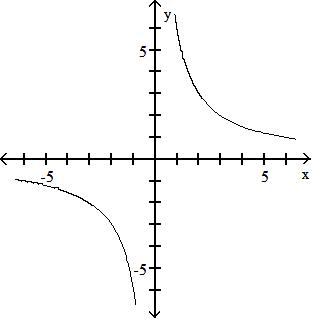
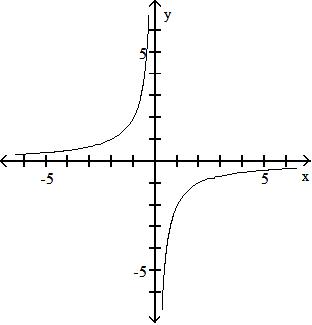

Objective: (1.5) Graph Functions Using Compressions and Stretches
242) f(x) = 2(x + 1)2 + 4


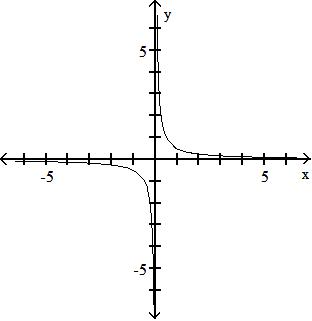

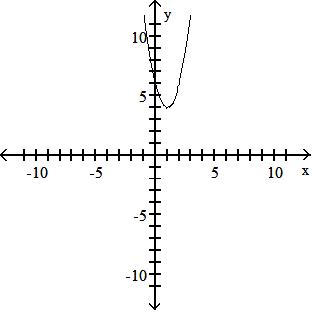
Objective: (1.5) Graph Functions Using Compressions and Stretches


Suppose the point (2, 4) is on the graph of y = f(x). Find a point on the graph of the given function.
243) y = 3f(x)
(2, 6)
(6, 4)
Objective: (1.5) Graph Functions Using Compressions and Stretches
(5, 2)
(2, 12)
Graph the function by starting with the graph of the basic function and then using the techniques of shifting, compressing, stretching, and/or reflecting.
244) f(x) =-x2





Objective: (1.5) Graph Functions Using Reflections about the x-Axis and the y-Axis
245) f(x) = (-x)2





Objective: (1.5) Graph Functions Using Reflections about the x-Axis and the y-Axis
246) f(x) =-x3




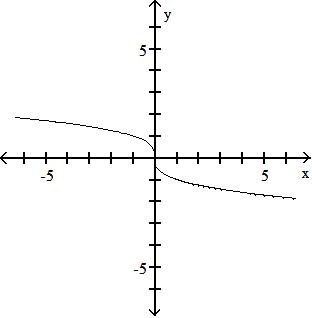
Objective: (1.5) Graph Functions Using Reflections about the x-Axis and the y-Axis
247) f(x) = (-x)3





Objective: (1.5) Graph Functions Using Reflections about the x-Axis and the y-Axis
248) f(x) =- x



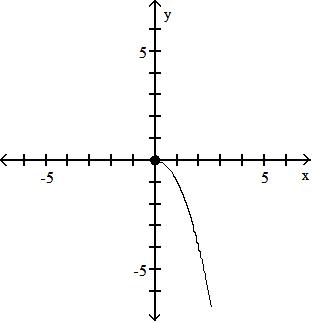
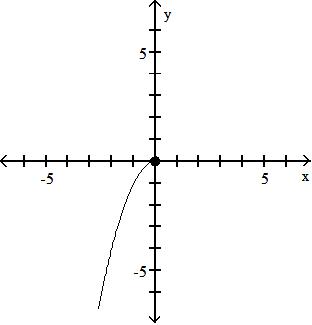
Objective: (1.5) Graph Functions Using Reflections about the x-Axis and the y-Axis
249) f(x) =-x

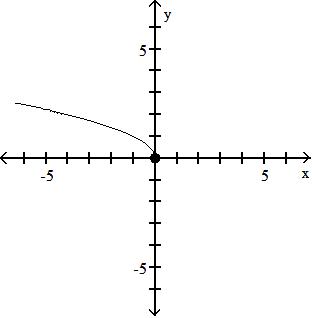



Objective: (1.5) Graph Functions Using Reflections about the x-Axis and the y-Axis 250) f(x) =-|x|



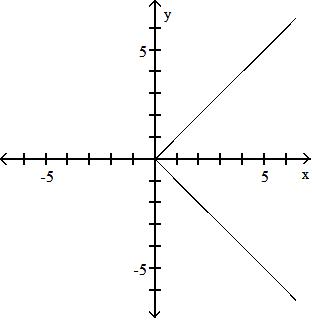

Objective: (1.5) Graph Functions Using Reflections about the x-Axis and the y-Axis
251) f(x) = |-x|





Objective: (1.5) Graph Functions Using Reflections about the x-Axis and the y-Axis
252) 1 f(x) =x

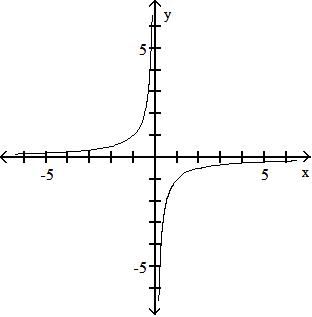


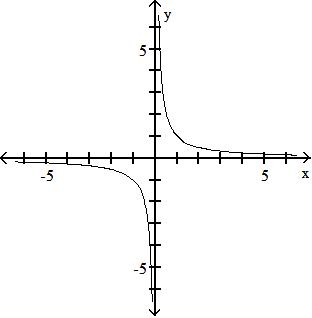
Objective: (1.5) Graph Functions Using Reflections about the x-Axis and the y-Axis
253) f(x) =-(x - 7)2 + 2


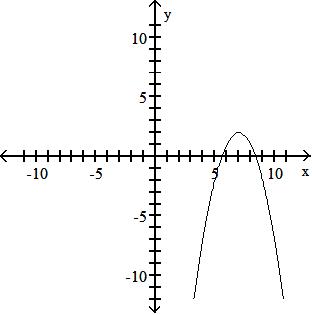

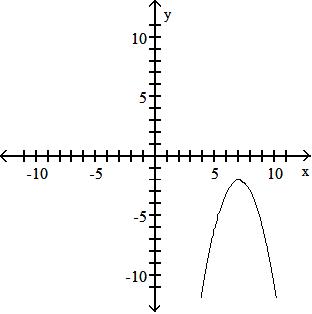
Objective: (1.5) Graph Functions Using Reflections about the x-Axis and the y-Axis
254) f(x) =-2(x + 1)2 + 3


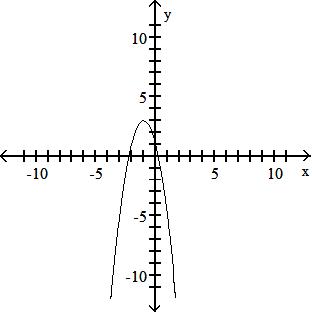

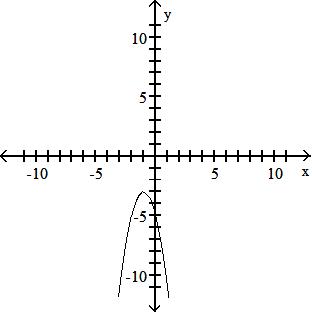
Objective: (1.5) Graph Functions Using Reflections about the x-Axis and the y-Axis
Match the correct function to the graph. 255)
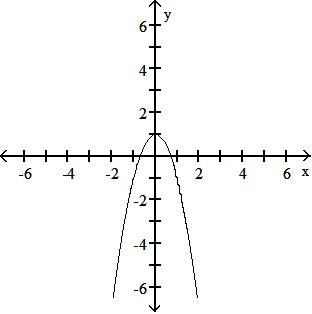
A) y = 1 - x2
B) y =-2x2
C) y =-2x2 + 1
Objective: (1.5) Graph Functions Using Reflections about the x-Axis and the y-Axis
Suppose the point (2, 4) is on the graph of y = f(x). Find a point on the graph of the given function.
256) The reflection of the graph of y = f(x) across the x-axis
A) (-2, -4)
B) (2, 4)
C) (-2, 4)
Objective: (1.5) Graph Functions Using Reflections about the x-Axis and the y-Axis
D) y =-2x2 - 1
D) (2, -4)
257) The reflection of the graph of y = f(x) across the y-axis
A) (-2, 4)
B) (2, -4)
C) (2, 4) D) (-2, -4)
Objective: (1.5) Graph Functions Using Reflections about the x-Axis and the y-Axis
Find the function.
258) Find the function that is finally graphed after the following transformations are applied to the graph of y = |x| The graph is shifted right 3 units, stretched by a factor of 3, shifted vertically down 2 units, and finally reflected across the x-axis. A) y =-3|x - 3| - 2
y =-(3|x + 3| - 2)
y =-(3|x - 3| - 2)
Objective: (1.5) Graph Functions Using Reflections about the x-Axis and the y-Axis
y = 3|-x - 3| - 2
259) Find the function that is finally graphed after the following transformations are applied to the graph of y = x The graph is shifted down 7 units, reflected about the x-axis, and finally shifted right 4 units.
A) y =- x - 4 - 7
y =-x + 4 - 7
y =- x - 4 + 7
Objective: (1.5) Graph Functions Using Reflections about the x-Axis and the y-Axis
260) Find the function that is finally graphed after the following transformations are applied to the graph of y = x The graph is shifted up 8 units, reflected about the y-axis, and finally shifted left 2 units.
y =-x + 2 - 8
Objective: (1.5) Graph Functions Using Reflections about the x-Axis and the y-Axis
Solve the problem.
261) Elissa wants to set up a rectangular dog run in her backyard. She has 20 feet of fencing to work with and wants to use it all. If the dog run is to be x feet long, express the area of the dog run as a function of x. A) A(x) = 9x - x2 B) A(x) = 12x2 - x C) A(x) = 10x - x2
A(x) = 11x - x2
Objective: (1.6) Build and Analyze Functions
262) Bob wants to fence in a rectangular garden in his yard. He has 66 feet of fencing to work with and wants to use it all. If the garden is to be x feet wide, express the area of the garden as a function of x.
= 33x - x2
Objective: (1.6) Build and Analyze Functions
263) Sue wants to put a rectangular garden on her property using 84 meters of fencing. There is a river that runs through her property so she decides to increase the size of the garden by using the river as one side of the rectangle. (Fencing is then needed only on the other three sides.) Let x represent the length of the side of the rectangle along the river. Express the garden's area as a function of x.
1 2
= 41x - x 4
= 42x - x
Objective: (1.6) Build and Analyze Functions
= 43x - 2x
2
1
= 42x - x2
264) A farmer has 1400 yards of fencing to enclose a rectangular garden. Express the area A of the rectangle as a function of the width x of the rectangle. What is the domain of A?
A) A(x) =-x2 + 700x; {x|0 < x < 700}
C) A(x) =-x2 + 1400x; {x|0 < x < 1400}
Objective: (1.6) Build and Analyze Functions
B) A(x) = x2 + 700x; {x|0 < x < 700}
D) A(x) =-x2 + 700x; {x|0 < x < 1400}
265) A rectangular sign is being designed so that the length of its base, in feet, is 2 feet less than 4 times the height, h. Express the area of the sign as a function of h.
A) A(h) =-2h + h2 B) A(h) =-2h2 + 2h
Objective: (1.6) Build and Analyze Functions
C) A(h) =-2h + 4h2 D) A(h) = 2h - 2h2
266) A rectangle that is x feet wide is inscribed in a circle of radius 31 feet. Express the area of the rectangle as a function of x.
A) A(x) = x 3844 - x2
C) A(x) = x2 1922 - x2
Objective: (1.6) Build and Analyze Functions
B) A(x) = x(3844 -x2)
D) A(x) = x 2883 - x
267) A wire of length 6x is bent into the shape of a square. Express the area A of the square as a function of x.
Objective: (1.6) Build and Analyze Functions
SHORT ANSWER. Write the word or phrase that best completes each statement or answers the question.
268) A right triangle has one vertex on the graph of y = x2 at (x, y), another at the origin, and the third on the (positive) y-axis at (0, y). Express the area A of the triangle as a function of x.
Objective: (1.6) Build and Analyze Functions
MULTIPLE CHOICE. Choose the one alternative that best completes the statement or answers the question.
269) The figure shown here shows a rectangle inscribed in an isosceles right triangle whose hypotenuse is 8 units long. Express the area A of the rectangle in terms of x.

A) A(x) = 2x(x - 4)
B) A(x) = 2x2
Objective: (1.6) Build and Analyze Functions
C) A(x) = 2x(4 - x)
D) A(x) = x(4 - x)
SHORT ANSWER. Write the word or phrase that best completes each statement or answers the question.
270) A wire 20 feet long is to be cut into two pieces. One piece will be shaped as a square and the other piece will be shaped as an equilateral triangle. Express the total area A enclosed by the pieces of wire as a function of the length x of a side of the equilateral triangle. What is the domain of A?
Objective: (1.6) Build and Analyze Functions
MULTIPLE CHOICE. Choose the one alternative that best completes the statement or answers the question.
271) A farmer's silo is the shape of a cylinder with a hemisphere as the roof. If the height of the silo is 74 feet and the radius of the hemisphere is r feet, express the volume of the silo as a function of r.
Objective: (1.6) Build and Analyze Functions
SHORT ANSWER. Write the word or phrase that best completes each statement or answers the question.
272) The volume V of a square-based pyramid with base sides s and height h is 1 V = s2h 3 If the height is half of the length of a base side, express the volume V as a function of s.
Objective: (1.6) Build and Analyze Functions
MULTIPLE CHOICE. Choose the one alternative that best completes the statement or answers the question.
273) A farmer's silo is the shape of a cylinder with a hemisphere as the roof. If the radius of the hemisphere is 10 feet and the height of the silo is h feet, express the volume of the silo as a function of h.
V(h) = 4100 π(h - 10) + π 7
V(h) =
πh + πh2 3
Objective: (1.6) Build and Analyze Functions
V(h) = 100 π(h2 - 10) + π 3
V(h) = 100 π(h - 10) + π 3
274) From a 34-inch by 34-inch piece of metal, squares are cut out of the four corners so that the sides can then be folded up to make a box. Let x represent the length of the sides of the squares, in inches, that are cut out. Express the volume of the box as a function of x.
A) V(x) = 4x3 - 136x2 + 1156x
C) V(x) = 2x3 - 102x2
Objective: (1.6) Build and Analyze Functions
B) V(x) = 2x3 - 102x2 + 34x
D) V(x) = 4x3 - 136x2
275) A box with an open top is to be constructed from a rectangular piece of cardboard with dimensions 11 inches by 28 inches by cutting out equal squares of side x at each corner and then folding up the sides as in the figure. Express the volume V of the box as a function of x.

A) V(x) = (11 - x)(28 - x)
C) V(x) = x(11 - 2x)(28 - 2x)
Objective: (1.6) Build and Analyze Functions
B) V(x) = (11 - 2x)(28 - 2x)
D) V(x) = x(11 - x)(28 - x)
276) A rectangular box with volume 465 cubic feet is built with a square base and top. The cost is $1.50 per square foot for the top and the bottom and $2.00 per square foot for the sides. Let x represent the length of a side of the base. Express the cost the box as a function of x. A) C(x) = 2x2 3720 + x B)
C(x) = 3x2 + x
Objective: (1.6) Build and Analyze Functions
277) The price p and the quantity x sold of a certain product obey the demand equation: 1 p =- x + 200, {x|0 ≤ x ≤ 700} 7
What is the revenue to the nearest dollar when 300 units are sold?
Objective: (1.6) Build and Analyze Functions
278) Let P = (x, y) be a point on the graph of y = x Express the distance d from P to the point (1, 0) as a function of x. A) d(x) = x2 + 2x + 2 B) d(x) = x2 - x + 1 C) d(x) = x2 + 2x + 2 D) d(x) = x2 - x + 1
Objective: (1.6) Build and Analyze Functions
SHORT ANSWER. Write the word or phrase that best completes each statement or answers the question.
279) The price p and x, the quantity of a certain product sold, obey the demand equation 1 p =- x + 100, {x|0 ≤ x ≤ 1000} 10
a) Express the revenue R as a function of x.
b) What is the revenue if 450 units are sold?
c) Graph the revenue function using a graphing utility.
d) What quantity x maximizes revenue? What is the maximum revenue?
e) What price should the company charge to maximize revenue?
Objective: (1.6) Build and Analyze Functions
280) Two boats leave a dock at the same time. One boat is headed directly east at a constant speed of 35 knots (nautical miles per hour), and the other is headed directly south at a constant speed of 22 knots. Express the distance d between the boats as a function of the time t.
Objective: (1.6) Build and Analyze Functions
MULTIPLE CHOICE. Choose the one alternative that best completes the statement or answers the question.
281) A rocket is shot straight up in the air from the ground at a rate of 43 feet per second. The rocket is tracked by a range finder that is 493 feet from the launch pad. Let d represent the distance from the rocket to the range finder and t represent the time, in seconds, since "blastoff". Express d as a function of t.
A) d(t) = 432 + (493t)2
C) d(t) = 493 + 43t2
Objective: (1.6) Build and Analyze Functions
B) d(t) = 4932 + (43t)2
D) d(t) = 4932 + (43t)2
If y varies directly as x, find a linear function which relates them.
282) y = 3 when x = 24 A) x f(x) = 3
f(x) = 8x
Objective: (1.7) Construct a Model Using Direct Variation
283) y = 15 when x = 27
Objective: (1.7) Construct a Model Using Direct Variation
284) y = 5 when 1 x = 3 A) f(x) = 15x
14 f(x) = x + 3
Objective: (1.7) Construct a Model Using Direct Variation
285) y = 0.8 when x = 0.2
Objective: (1.7) Construct a Model Using Direct Variation
286) y = 0.4 when x = 2 A) f(x) = 0.2x B) f(x) = x - 1.6
Objective: (1.7) Construct a Model Using Direct Variation
f(x) = x + 21
x f(x) = 8
x f(x) = 15
x f(x) = 5
f(x) = 0.4x
f(x) = 5x
Solve.
287) The amount of water used to take a shower is directly proportional to the amount of time that the shower is in use. A shower lasting 24 minutes requires 14.4 gallons of water. Find the amount of water used in a shower lasting 8 minutes.
A) 5.4 gallons
B) 4.2 gallons
Objective: (1.7) Construct a Model Using Direct Variation
C) 192 gallons
D) 4.8 gallons
288) If the resistance in an electrical circuit is held constant, the amount of current flowing through the circuit varies directly with the amount of voltage applied to the circuit. When 9 volts are applied to a circuit, 180 milliamperes of current flow through the circuit. Find the new current if the voltage is increased to 10 volts.
A) 190 milliamperes B) 220 milliamperes C) 90 milliamperes D) 200 milliamperes
Objective: (1.7) Construct a Model Using Direct Variation
289) The amount of gas that a helicopter uses is directly proportional to the number of hours spent flying. The helicopter flies for 4 hours and uses 32 gallons of fuel. Find the number of gallons of fuel that the helicopter uses to fly for 5 hours.
A) 20 gallons
B) 45 gallons
Objective: (1.7) Construct a Model Using Direct Variation
C) 48 gallons
D) 40 gallons
Solve the problem.
290) When the temperature stays the same, the volume of a gas is inversely proportional to the pressure of the gas. If a balloon is filled with 348 cubic inches of a gas at a pressure of 14 pounds per square inch, find the new pressure of the gas if the volume is decreased to 58 cubic inches.
A) 70 pounds per square inch
C) 84 pounds per square inch
Objective: (1.7) Construct a Model Using Inverse Variation
B) 29 7 pounds per square inch
D) 78 pounds per square inch
291) If the force acting on an object stays the same, then the acceleration of the object is inversely proportional to its mass. If an object with a mass of 6 kilograms accelerates at a rate of 2 meters per second per second by a force, find the rate of acceleration of an object with a mass of 2 kilograms that is pulled by the same force.
A) 6 meters per second per second
C) 3 meters per second per second
Objective: (1.7) Construct a Model Using Inverse Variation
B) 2 3 meters per second per second
D) 4 meters per second per second
292) While traveling at a constant speed in a car, the centrifugal acceleration passengers feel while the car is turning is inversely proportional to the radius of the turn. If the passengers feel an acceleration of 6 feet per second per second when the radius of the turn is 80 feet, find the acceleration the passengers feel when the radius of the turn is 240 feet.
A) 4 feet per second per second
B) 2 feet per second per second
C) 3 feet per second per second D) 5 feet per second per second
Objective: (1.7) Construct a Model Using Inverse Variation
293) The amount of time it takes a swimmer to swim a race is inversely proportional to the average speed of the swimmer. A swimmer finishes a race in 500 seconds with an average speed of 3 feet per second. Find the average speed of the swimmer if it takes 375 seconds to finish the race.
A) 5 feet per second B) 3 feet per second C) 6 feet per second D) 4 feet per second
Objective: (1.7) Construct a Model Using Inverse Variation
294) If the voltage, V, in an electric circuit is held constant, the current, I, is inversely proportional to the resistance, R. If the current is 100 milliamperes when the resistance is 4 ohms, find the current when the resistance is 20 ohms.
A) 20 milliamperes B) 495 milliamperes C) 80 milliamperes D) 500 milliamperes
Objective: (1.7) Construct a Model Using Inverse Variation
295) The gravitational attraction A between two masses varies inversely as the square of the distance between them. The force of attraction is 4 lb when the masses are 3 ft apart, what is the attraction when the masses are 6 ft apart? A) 2 lb B) 1 lb C) 3 lb D) 4 lb
Objective: (1.7) Construct a Model Using Inverse Variation
Solve.
296) The amount of paint needed to cover the walls of a room varies jointly as the perimeter of the room and the height of the wall. If a room with a perimeter of 65 feet and 6-foot walls requires 3.9 quarts of paint, find the amount of paint needed to cover the walls of a room with a perimeter of 45 feet and 6-foot walls.
A) 27 quarts B) 2.7 quarts C) 270 quarts D) 5.4 quarts
Objective: (1.7) Construct a Model Using Joint or Combined Variation
297) The amount of simple interest earned on an investment over a fixed amount of time is jointly proportional to the principle invested and the interest rate. A principle investment of $1400.00 with an interest rate of 1% earned $14.00 in simple interest. Find the amount of simple interest earned if the principle is $4900.00 and the interest rate is 2%. A) $28.00 B) $9800.00
$49.00
Objective: (1.7) Construct a Model Using Joint or Combined Variation
298) The voltage across a resistor is jointly proportional to the resistance of the resistor and the current flowing through the resistor. If the voltage across a resistor is 14 volts for a resistor whose resistance is 2 ohms and when the current flowing through the resistor is 7 amperes, find the voltage across a resistor whose resistance is 3 ohms and when the current flowing through the resistor is 5 amperes.
A) 10 volts B) 35 volts C) 21 volts D) 15 volts
Objective: (1.7) Construct a Model Using Joint or Combined Variation
299) The power that a resistor must dissipate is jointly proportional to the square of the current flowing through the resistor and the resistance of the resistor. If a resistor needs to dissipate 441 watts of power when 7 amperes of current is flowing through the resistor whose resistance is 9 ohms, find the power that a resistor needs to dissipate when 6 amperes of current are flowing through a resistor whose resistance is 5 ohms.
A) 210 watts B) 150 watts
C) 180 watts D) 30 watts
Objective: (1.7) Construct a Model Using Joint or Combined Variation
300) While traveling in a car, the centrifugal force a passenger experiences as the car drives in a circle varies jointly as the mass of the passenger and the square of the speed of the car. If the a passenger experiences a force of 14.4 newtons when the car is moving at a speed of 20 kilometers per hour and the passenger has a mass of 40 kilograms, find the force a passenger experiences when the car is moving at 40 kilometers per hour and the passenger has a mass of 60 kilograms.
A) 96 newtons
B) 112 newtons
C) 76.8 newtons
Objective: (1.7) Construct a Model Using Joint or Combined Variation
D) 86.4 newtons
301) The volume V of a given mass of gas varies directly as the temperature T and inversely as the pressure P. A measuring device is calibrated to give V = 126.5 in3 when T = 230° and P = 20 lb/in2 What is the volume on this device when the temperature is 110° and the pressure is 25 lb/in2?
A) V = 88.4 in3
B) V = 4.4 in3
C) V = 48.4 in3
Objective: (1.7) Construct a Model Using Joint or Combined Variation
D) V = 8.4 in3
302) The time in hours it takes a satellite to complete an orbit around the earth varies directly as the radius of the orbit (from the center of the earth) and inversely as the orbital velocity. If a satellite completes an orbit 650 miles above the earth in 13 hours at a velocity of 34,000 mph, how long would it take a satellite to complete an orbit if it is at 1700 miles above the earth at a velocity of 25,000 mph? (Use 3960 miles as the radius of the earth.)
A) 46.24 hours
B) 217.07 hours
C) 6.52 hours
Objective: (1.7) Construct a Model Using Joint or Combined Variation
D) 21.71 hours
Answer Key
1) A 2) C 3) A 4) A 5) C 6) A 7) A 8) A 9) A 10) A 11) B 12) B 13) B 14) B 15) A 16) A 17) B 18) A 19) A 20) C 21) C 22) A 23) D 24) A 25) D 26) A 27) C 28) C
29) A 30) B 31) C
32) A 33) D 34) B 35) D
36) D 37) D
38) D
39) D
40) A 41) C
42) C
43) A 44) A 45) C 46) C
47) D
48) C
49) D 50) B
51) D 52) C 53) C 54) C 55) D 56) C 57) A 58) D 59) D 60) A 61) C 62) C 63) C 64) B 65) D 66) C 67) C 68) B 69) D 70) C 71) D 72) A 73) A 74) B 75) A 76) D 77) D 78) B 79) C 80) C 81) D 82) C 83) D 84) A 85) B 86) A 87) A 88) D 89) B 90) A 91) B 92) D 93) B 94) D 95) C 96) D 97) C 98) B 99) 100) B 101) A 102) A 103) A 104) C 105) C 106) B 107) B 108) B 109) A 110) B 111) A 112) A 113) C 114) B 115) C 116) A 117) A 118) B 119) B 120) B 121) B 122) B 123) C 124) B 125) A 126) A 127) C 128) B 129) B 130) C 131) C 132) C 133) D 134) B 135) A
136) D 137) B 138) B 139) C 140) D 141) D 142) C 143) A 144) B 145) D 146) C 147) A
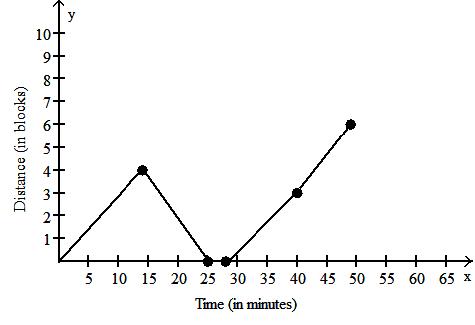
148) local maximum at (0, 6) local minimum at (2.67, -3.48) increasing on (-1, 0) and (2.67, 4) decreasing on (0, 2.67)
149) local maximum at (0, 0)
local minimum at (0.74, -0.33) increasing on (-2, 0) and (0.74, 2) decreasing on (0, 0.74)
150) local maximum at (2.34, 1.61) local minimum at (-1.9, -9.82) increasing on (-1.9, 2.34)
decreasing on (-4, -1.9) and (2.34, 5) 151) local maximum at (0, 5)
local minima at (-2.55, 1.17) and (1.05, 4.65) increasing on (-2.55, 0) and (1.05, 2) decreasing on (-4, -2.55) and (0, 1.05)
152) B
153) B
154) B
155) A
156) A
Answer Key
157) B
158) B
159) D
160) B
161) C
162) C
163) D 164) B
165) D
166) A
167) D 168) B
169) C
170) D 171) A
172) D 173) B
174) D 175) D
176) A
177) A
178) A
179) C 180) C
181) A 182) C
183) D
184) A
185) D
186) D
187) D
188) D
189) A
190) D 191) A
192) A
193) D
194) A 195) B
196) B
197) B
198) B
199) D 200) B
201) D
202) A
203) A 204) B
205) A
206) $25.52
$42.69
C(x) = 8.8 + 0.6686x if 4.0475 + 0.8587x if 207) $39.70
$49.69
C(x) = 4.93 + 0.11589x -0.266 + 0.13321x if 0 ≤ x ≤ 300 if x > 300 208) $18.00
$24.25
$65.50
209) 6.0°C 210) $27.50 $32.50; C(x) = 20 12.5 + 0.075x 7.5 + 0.1x if 0 ≤ x ≤ 100 if 100 < x ≤ 200 if x > 200 211) A
212) A 213) A 214) C 215) B 216) B 217) B 218) D 219) A 220) B 221) D 222) B 223) A 224) A 225) C 226) C 227) B 228) D 229) D 230) D 231) D 232) A 233) A 234) D 235) D
236) A 237) B 238) C 239) D 240) D 241) D 242) B 243) D 244) C 245) A 246) A 247) B 248) A 249) A 250) A 251) B 252) A 253) C 254) C 255) C 256) D 257) A 258) C 259) A 260) B 261) C 262) A 263) D 264) A 265) C 266) A 267) C 268) A(x) = x3 2 1 269) C 270) A(x) = x216 15 x + 25; {x|0 ≤ x ≤ 2 20 } 3 4 3 + 9 271) B
272) V(s) = s3 6 1
273) D 274) A 275) C 276) B
277) B 278) B
279) a. R(x) =- x2 10 100x 1 b. R(450) = $24,750.00 c. + d. 500; $25,000.00 e. $50.00
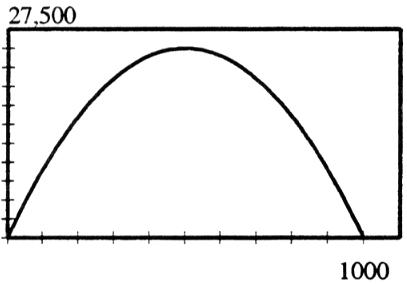
280) d(t) = 1709t 281) B 282) D 283) C 284) A 285) C 286) A
287) D 288) D 289) D 290) C 291) A
292) B
293) D 294) A 295) B 296) B 297) D 298) D 299) C 300) D
301) C
302) D
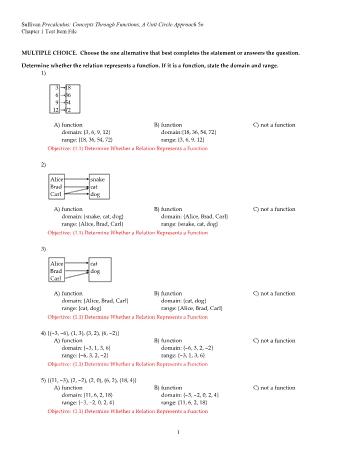
RESULT

Title
Chapter 1 Test Item File
Filename spuca5e_TI_01.pdf
Date/Time Standard
2023-12-06 15:57
ABOUT PAC The PDF/UA requirements checked by PAC are fulfilled.
Version: 21.0.0.0 OS: Windows
PDF/UA-1
PDF Accessibility Checker (PAC) evaluates the accessibility of PDF files according to ISO Standard 14289-1 (PDF/UA) by using the Matterhorn Protocol. It checks 107 criteria that can be checked automatically.
PAC is a free checking tool of the PDF/UA Foundation: www.pdfua.foundation Copyright © 2021 PDF/UA Foundation.
